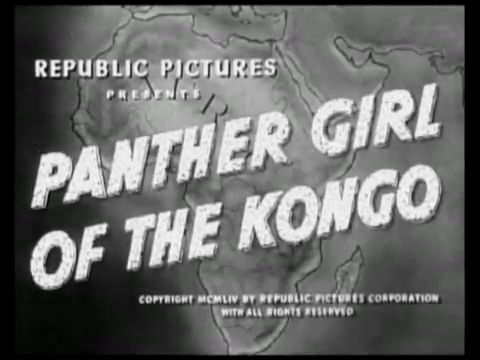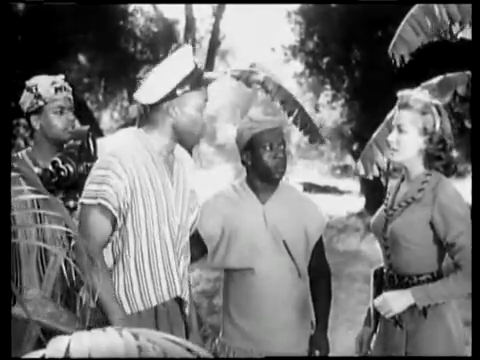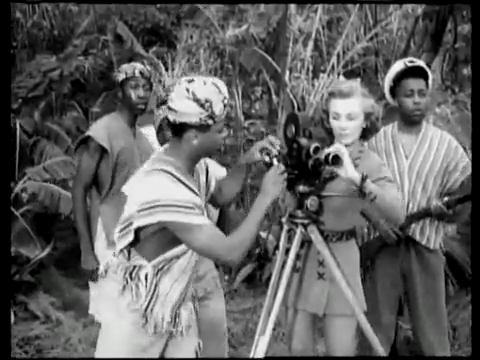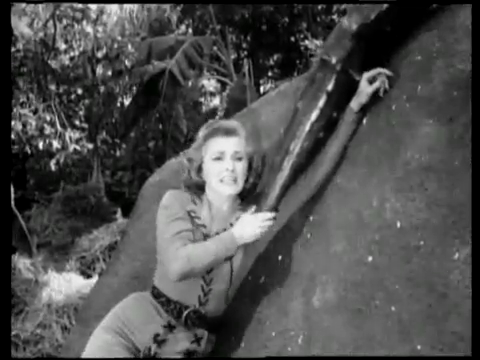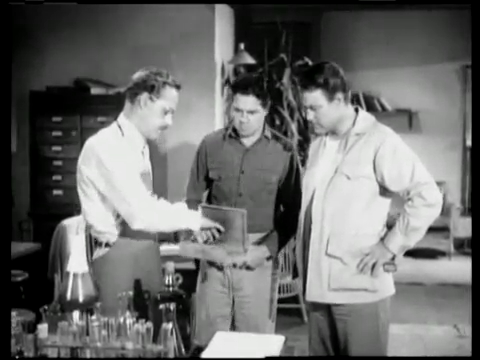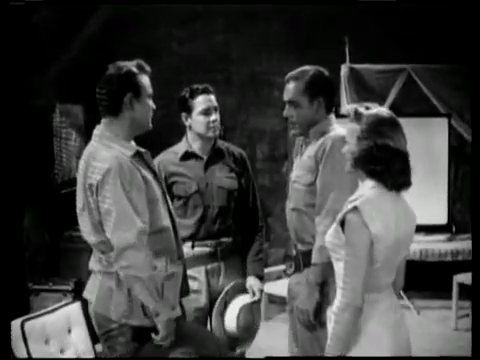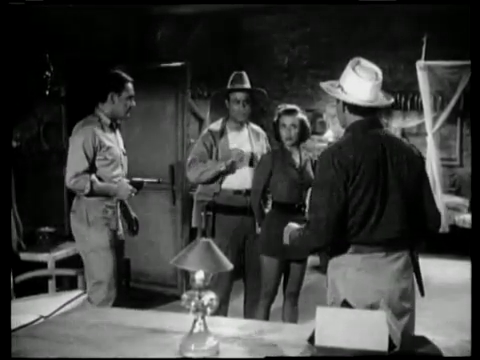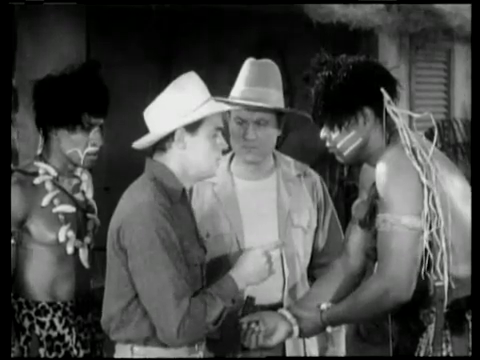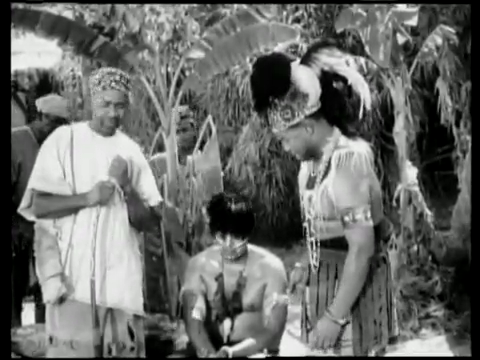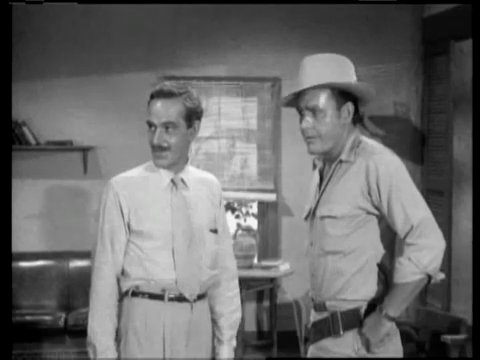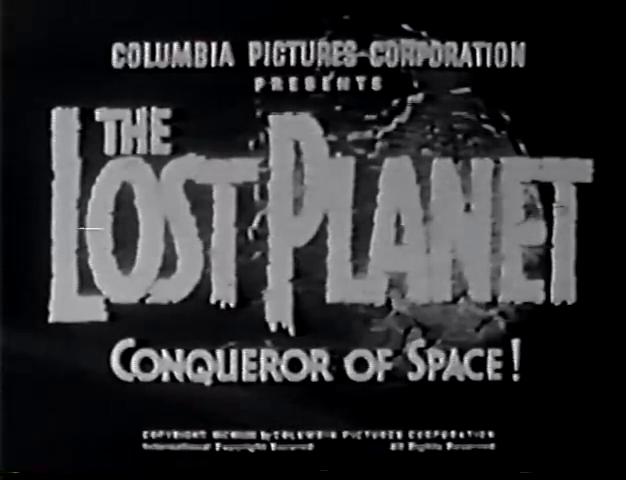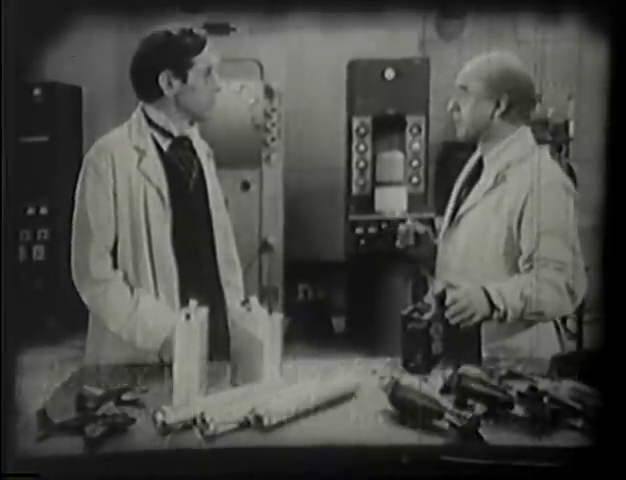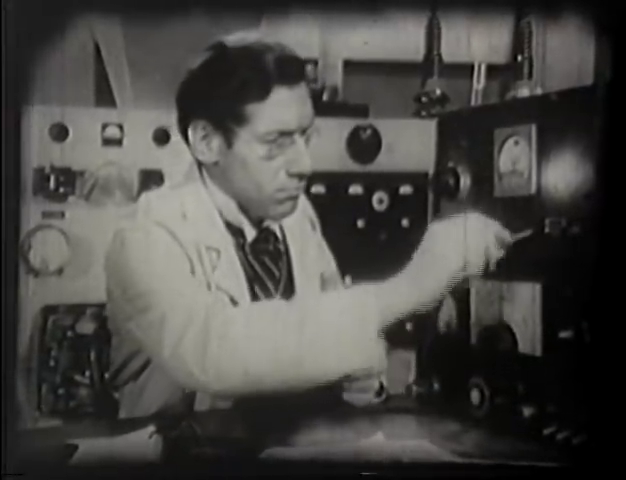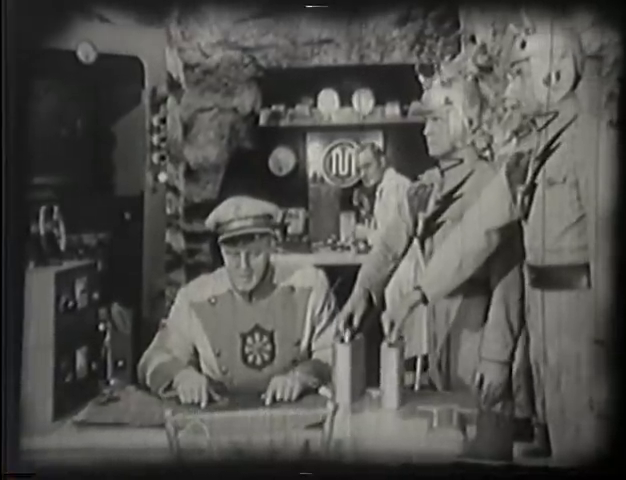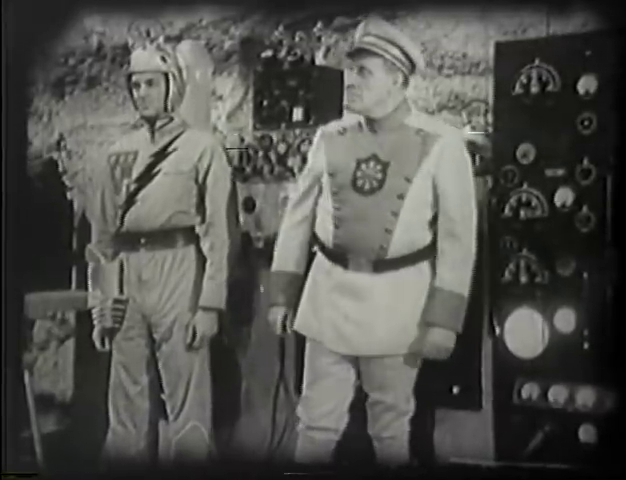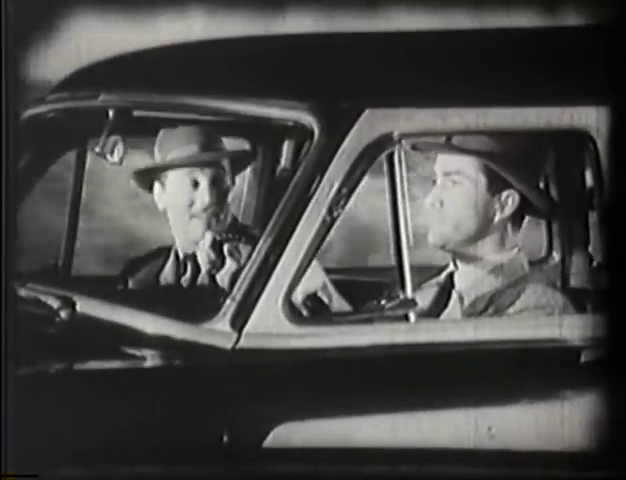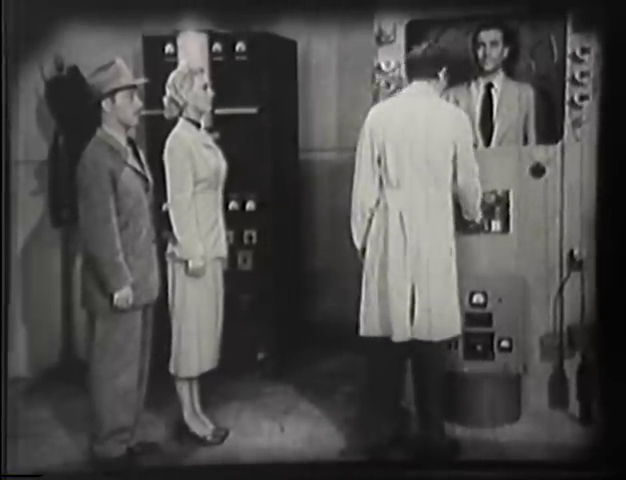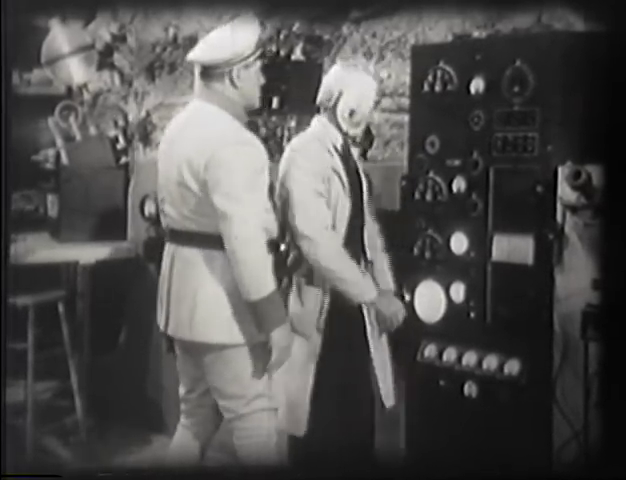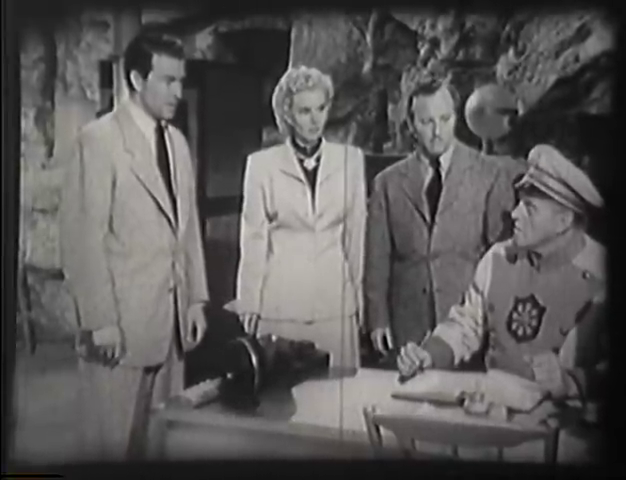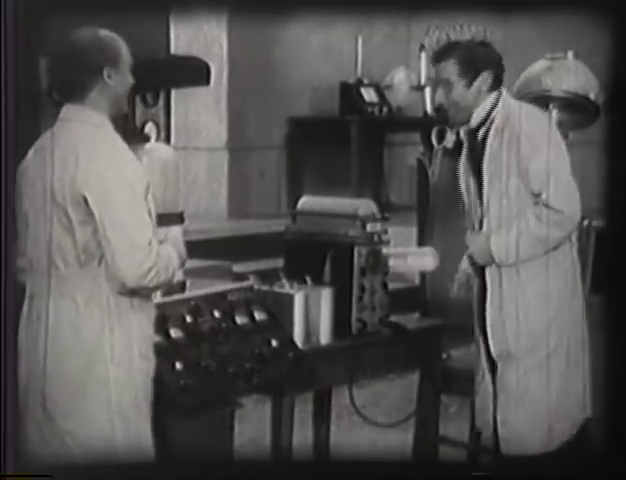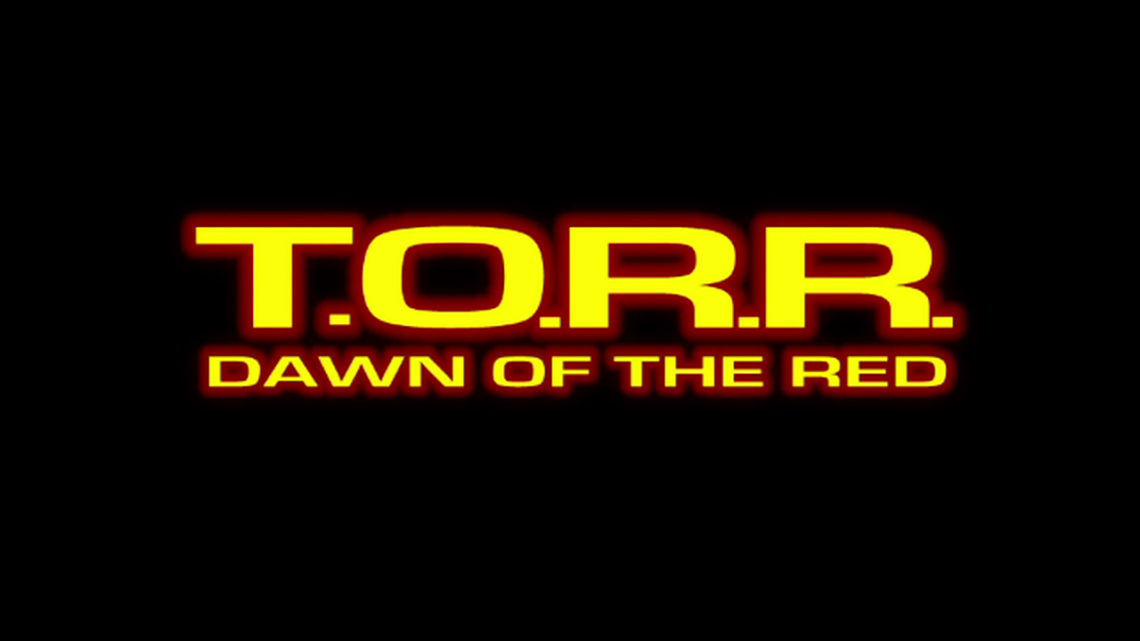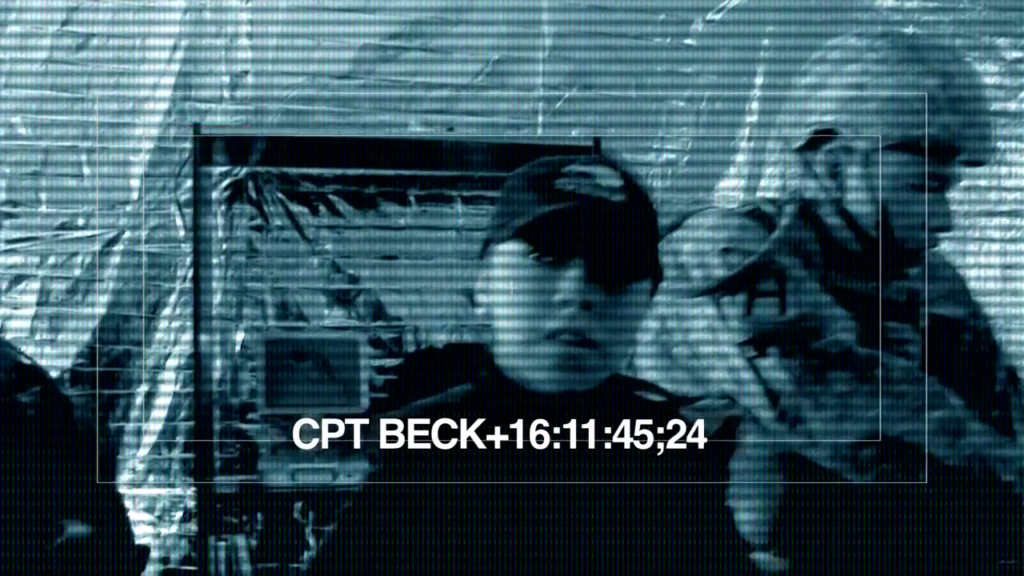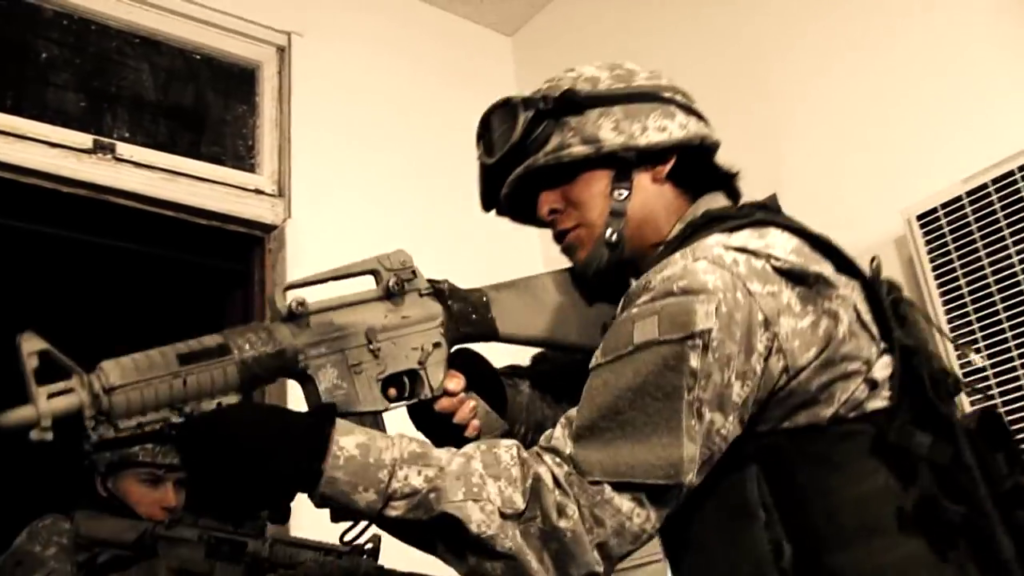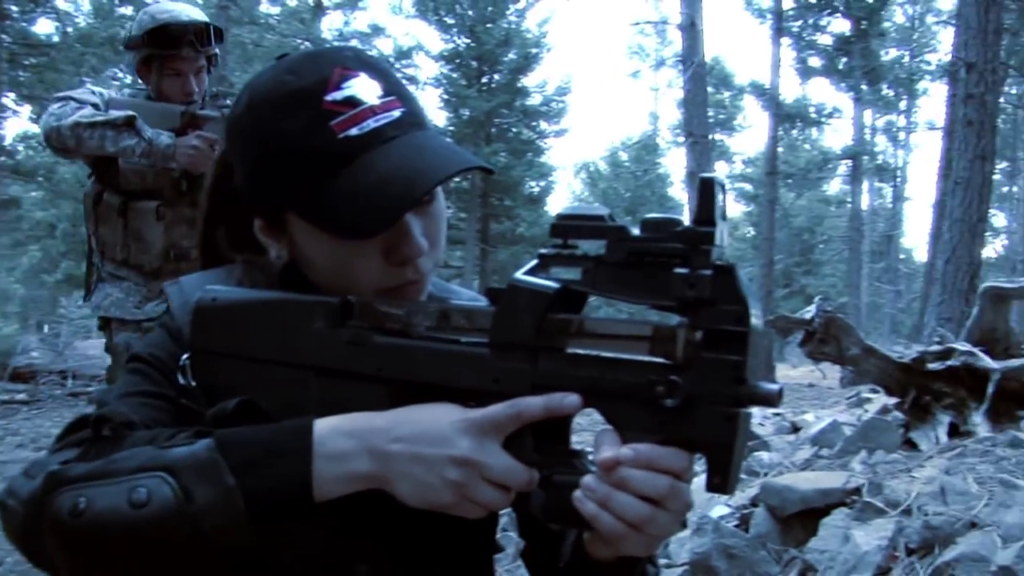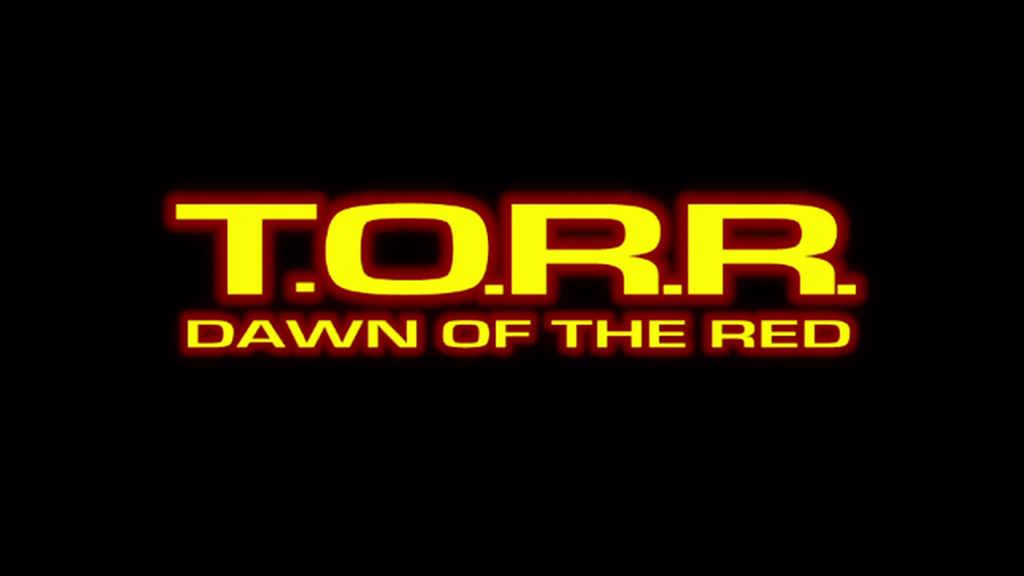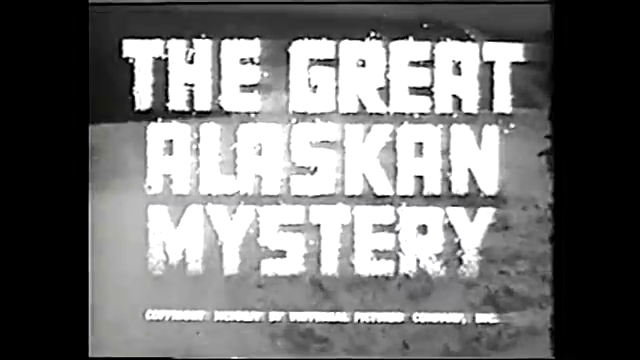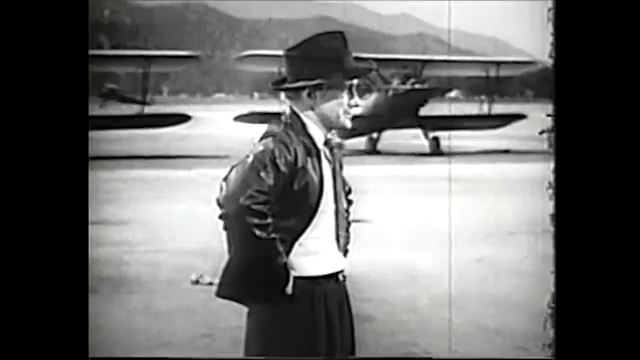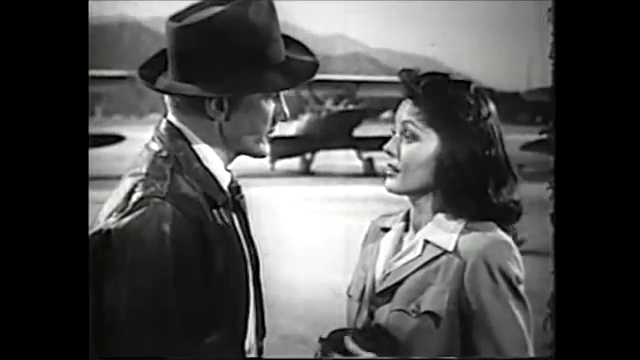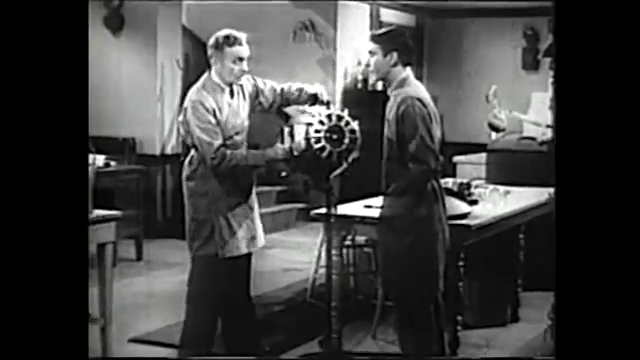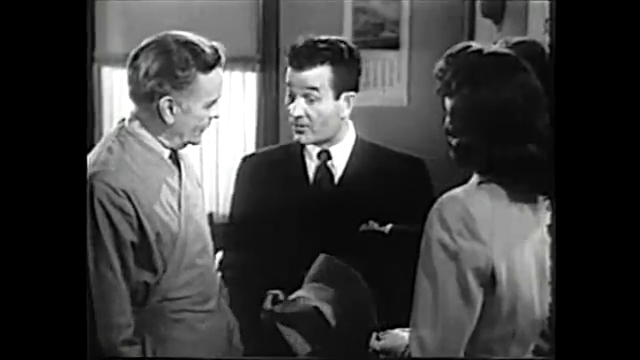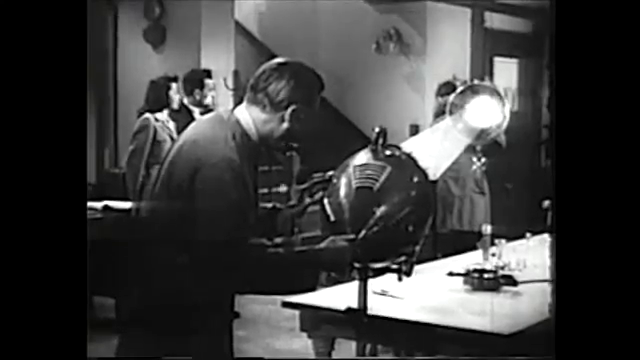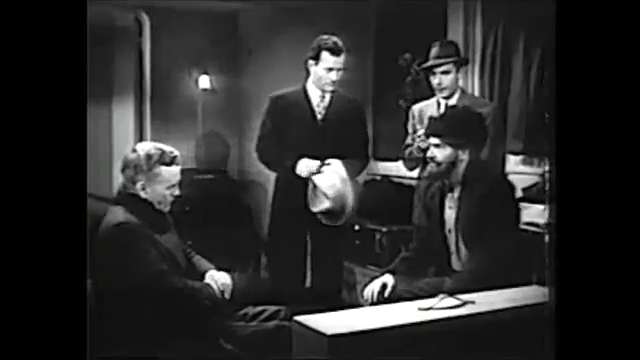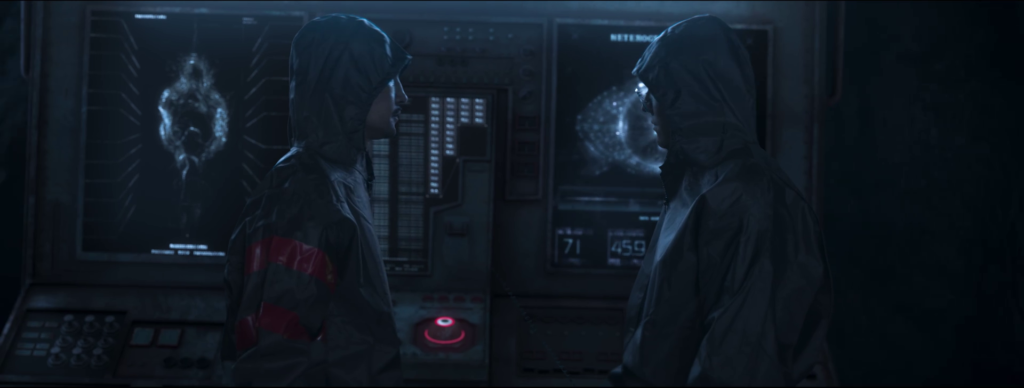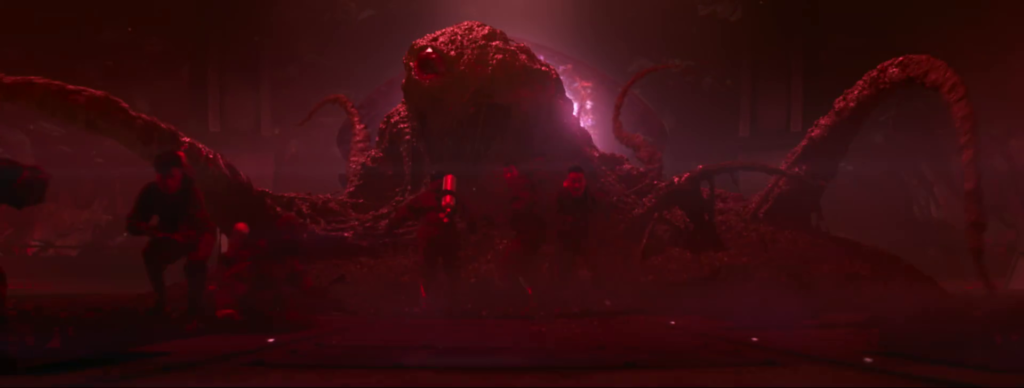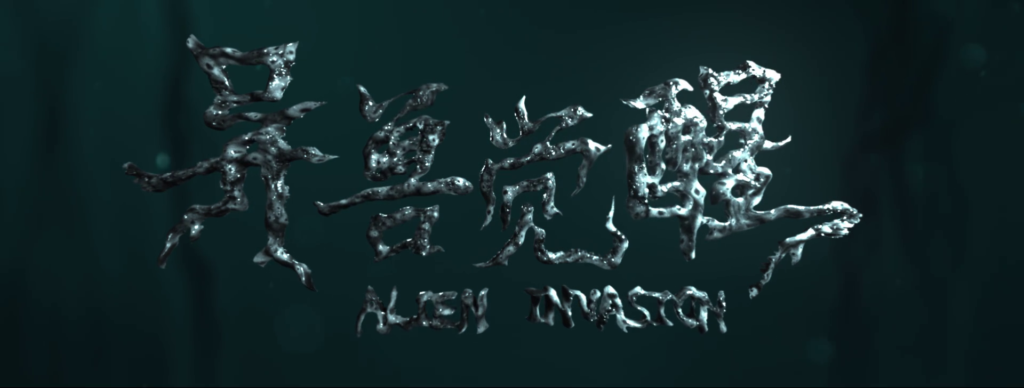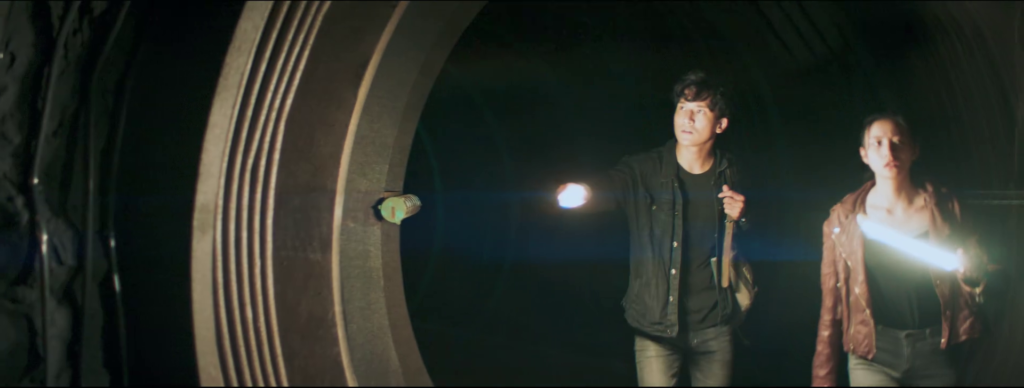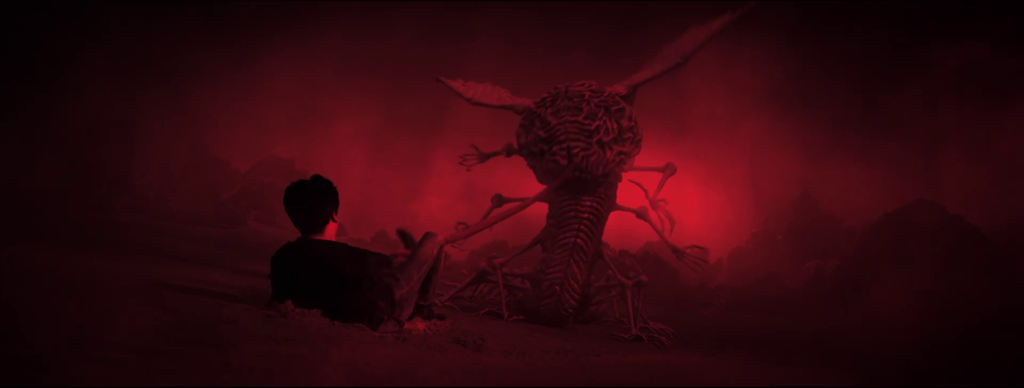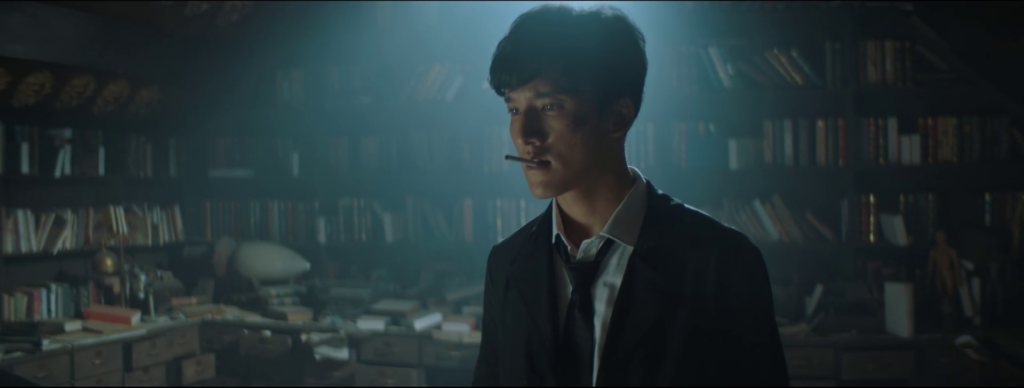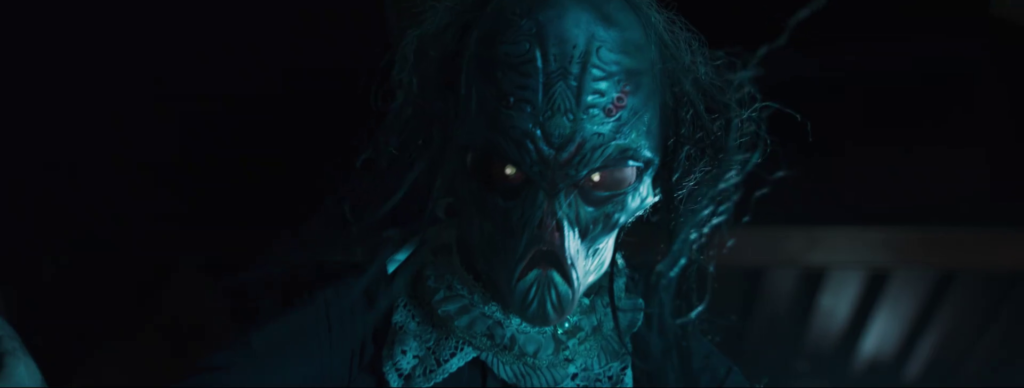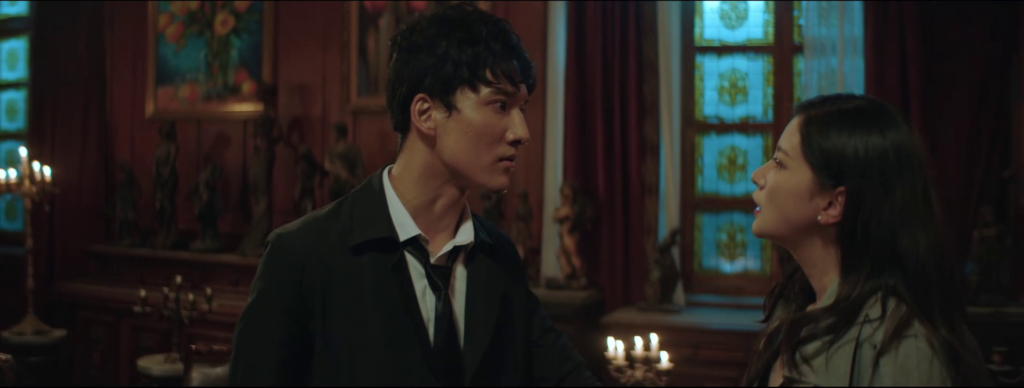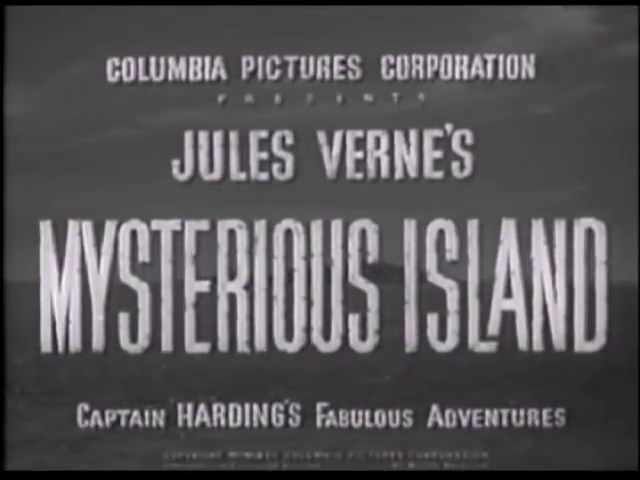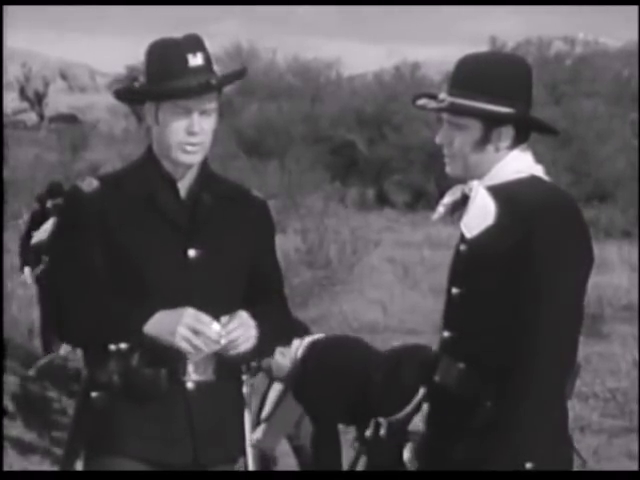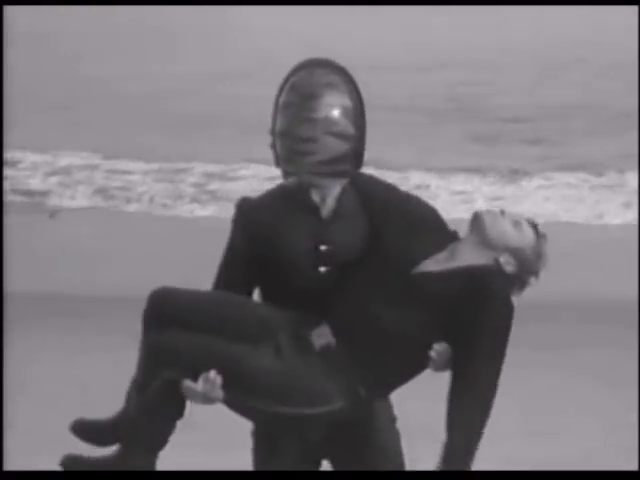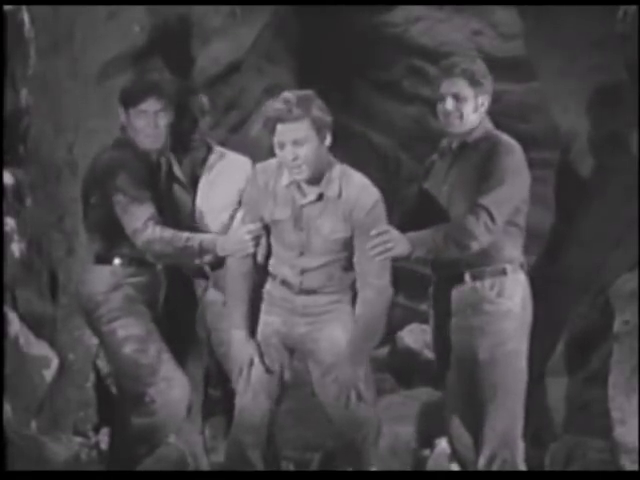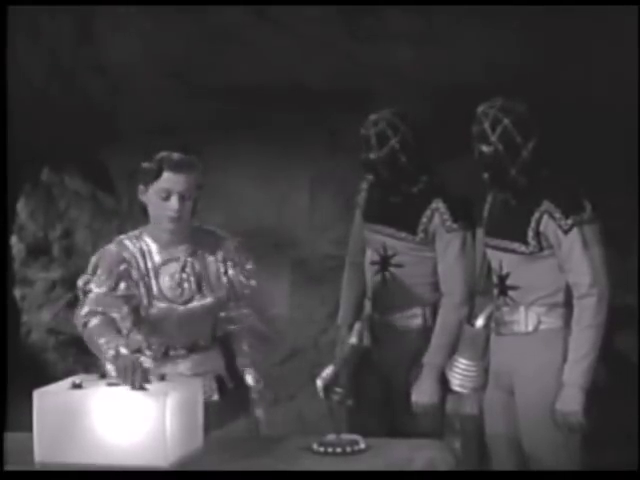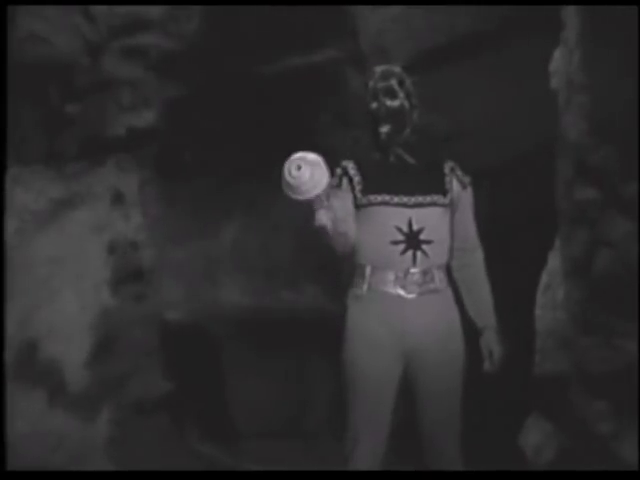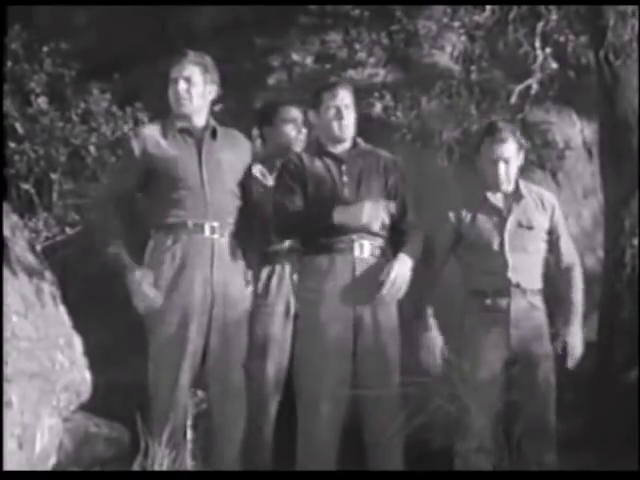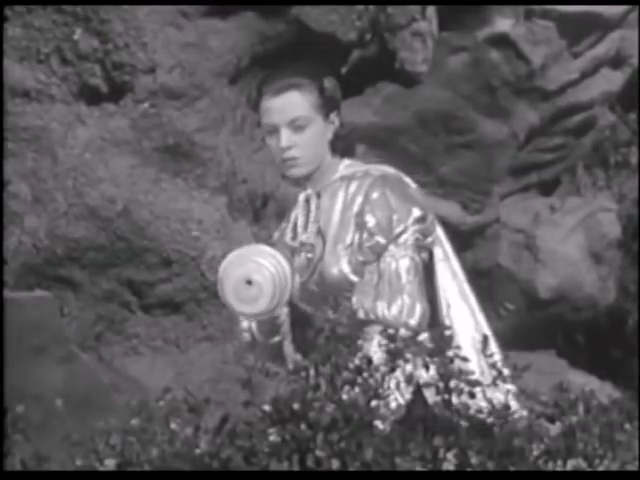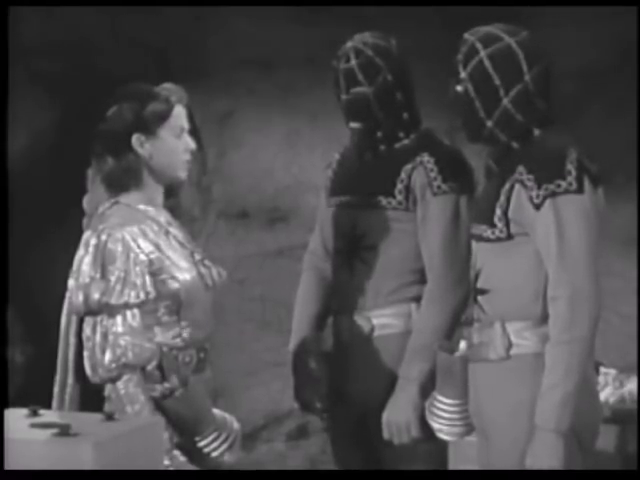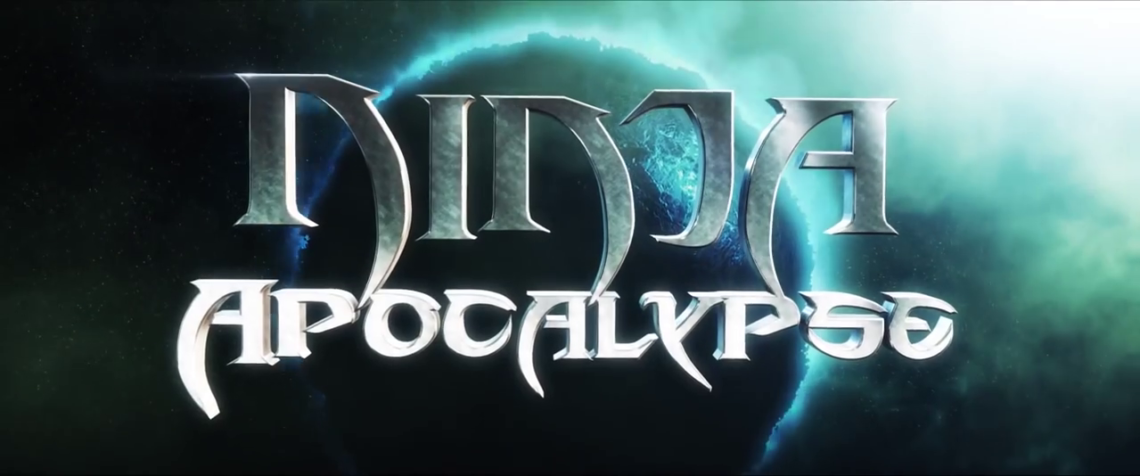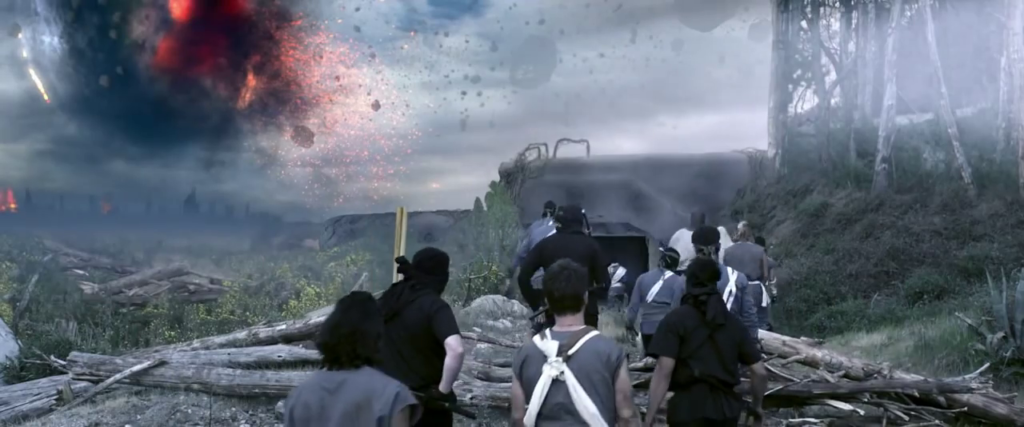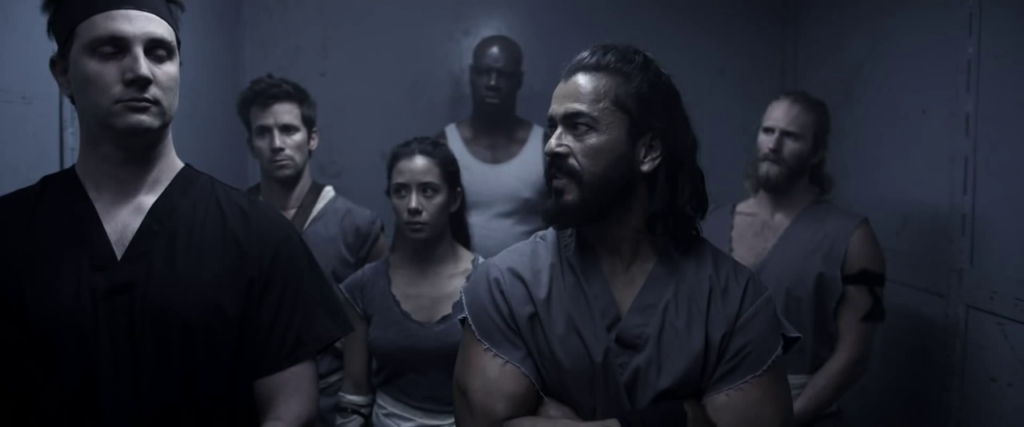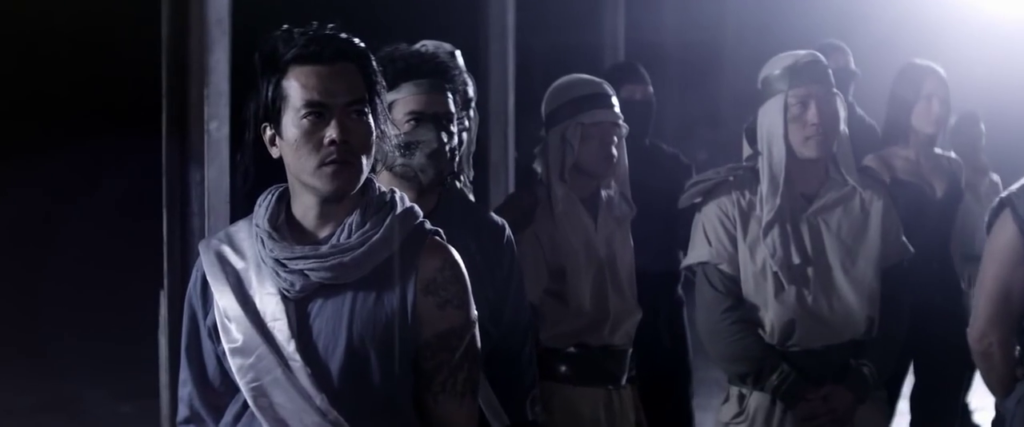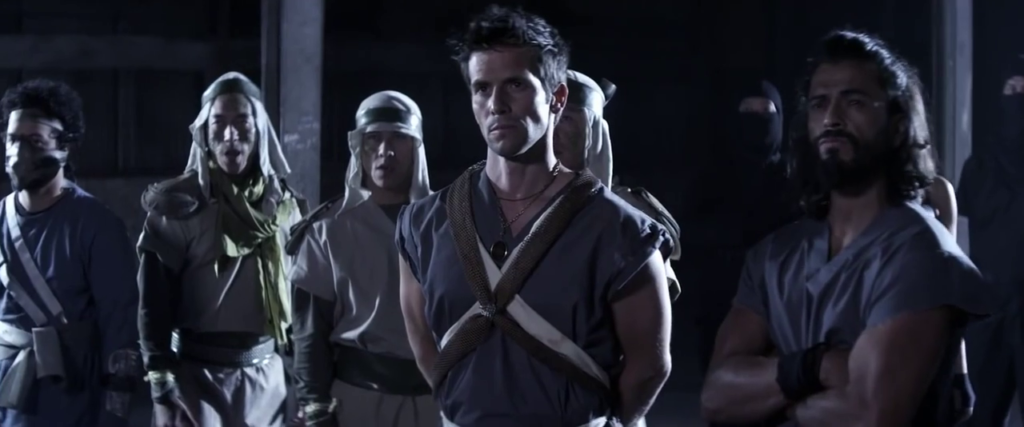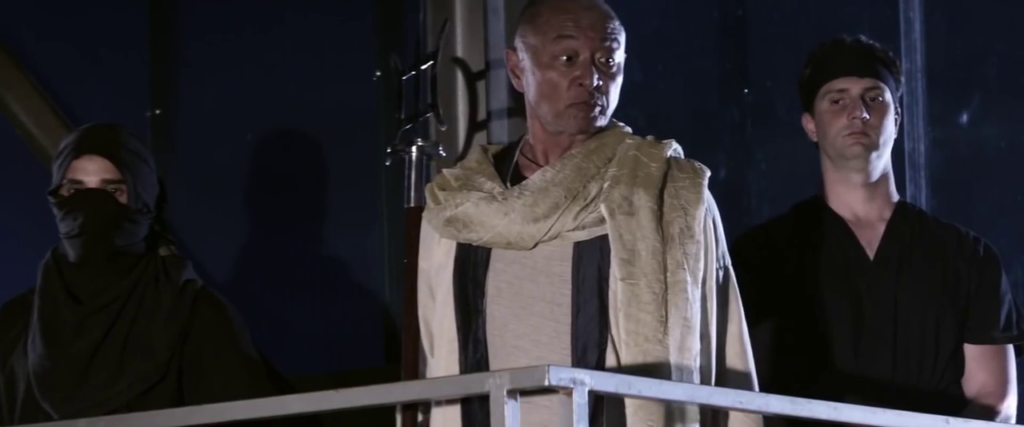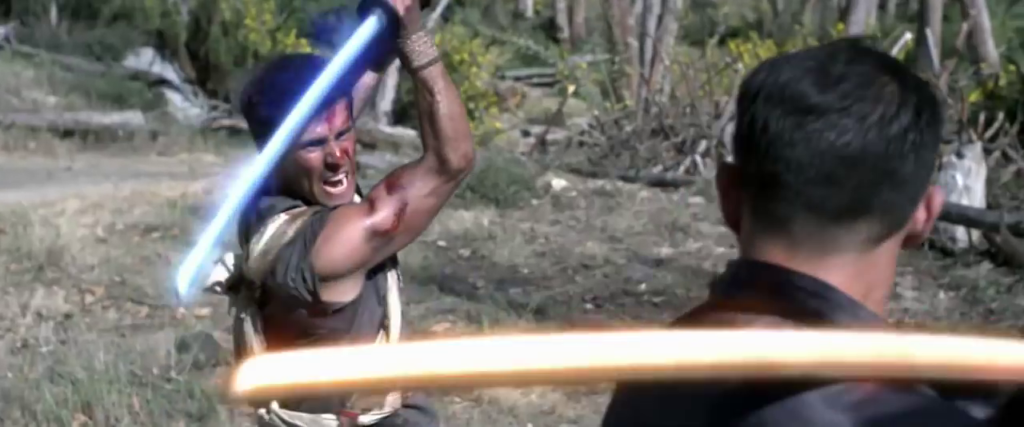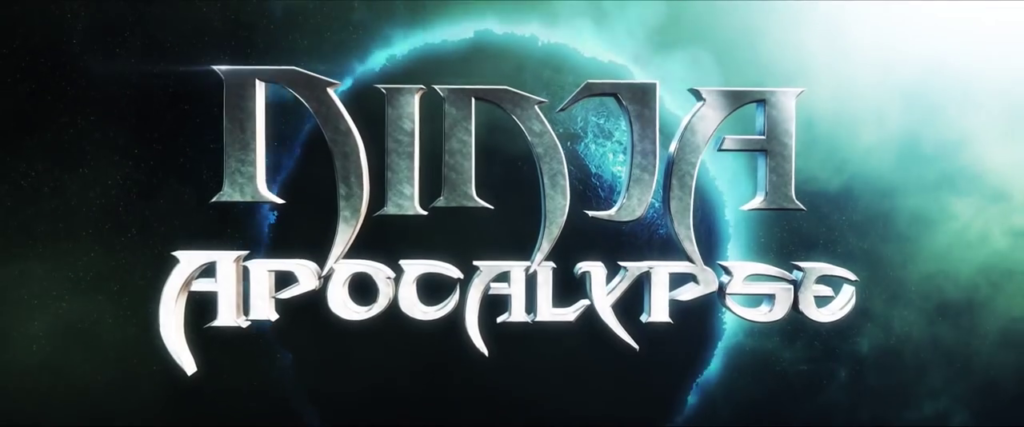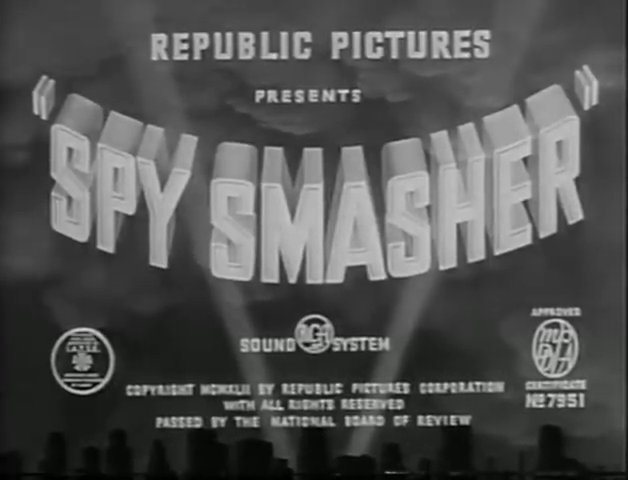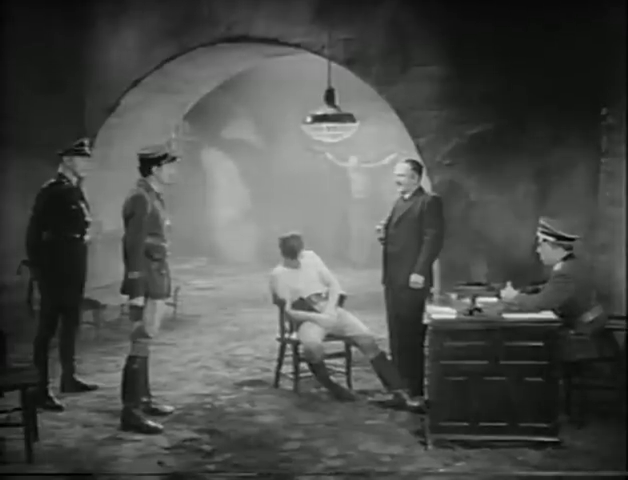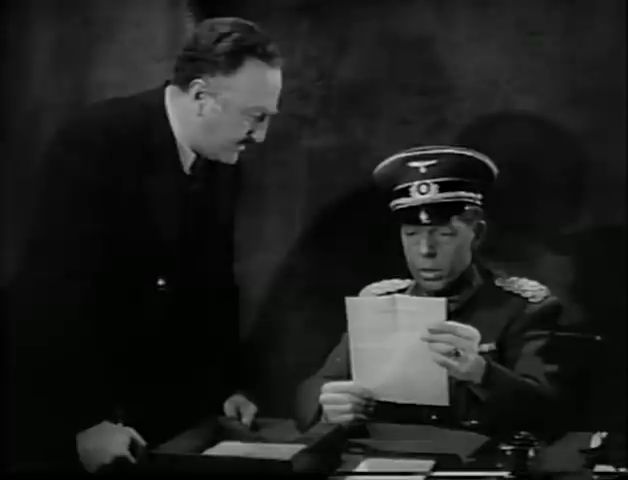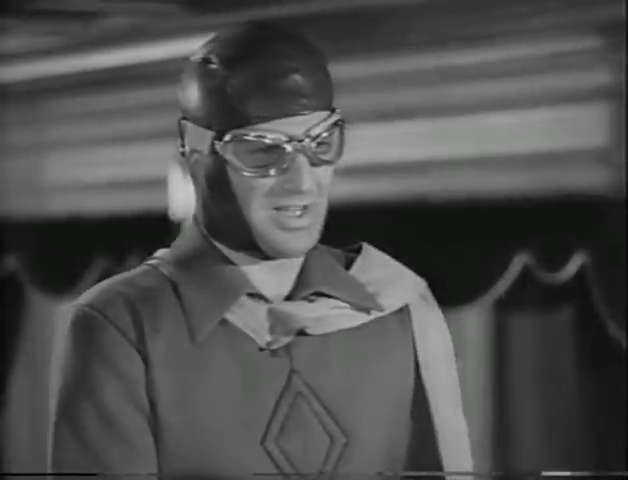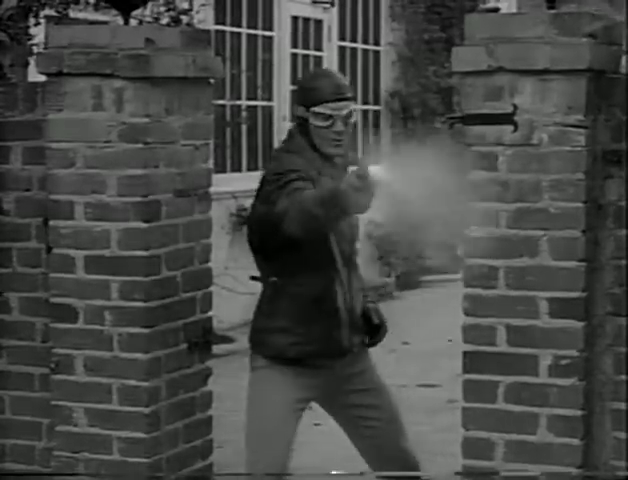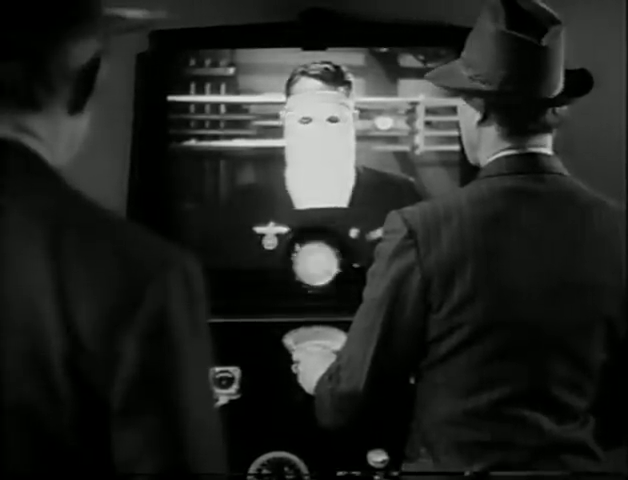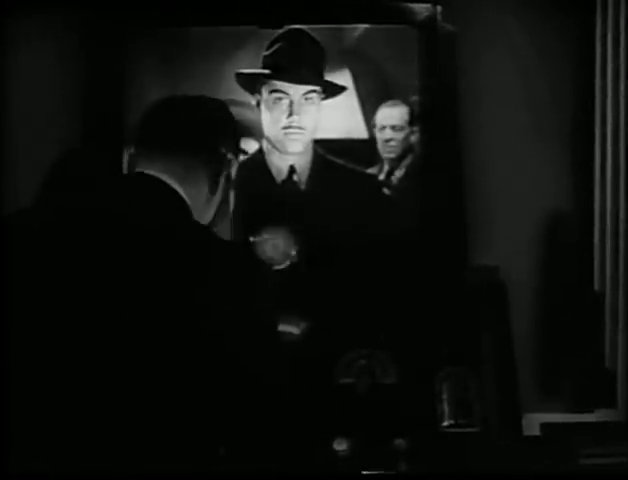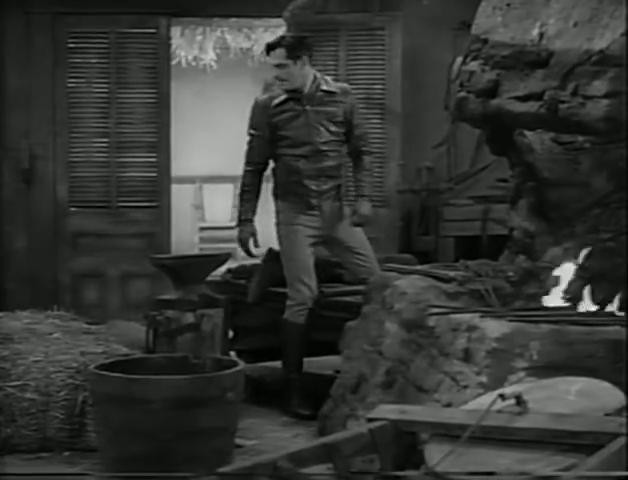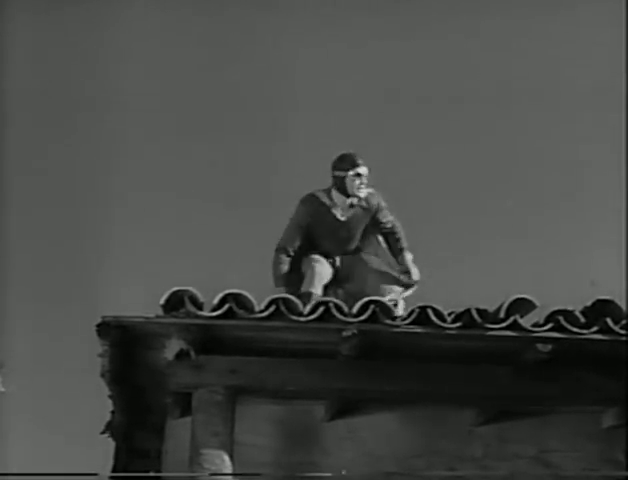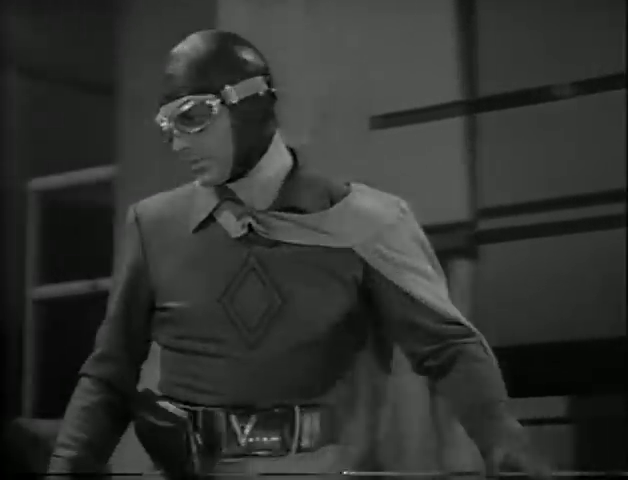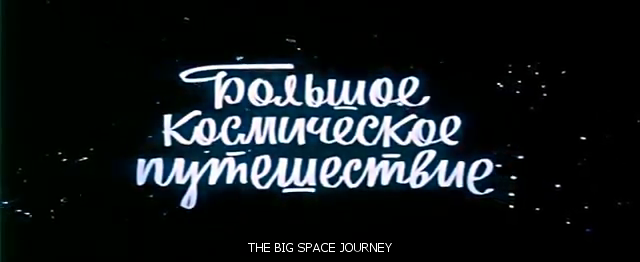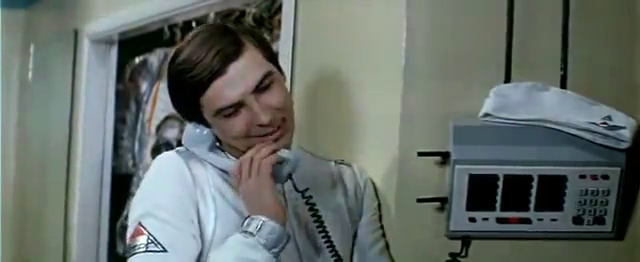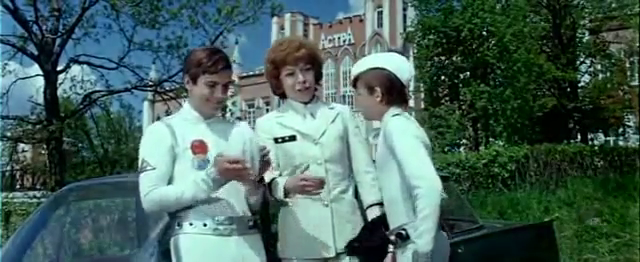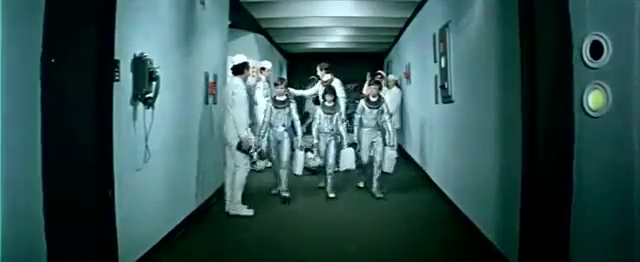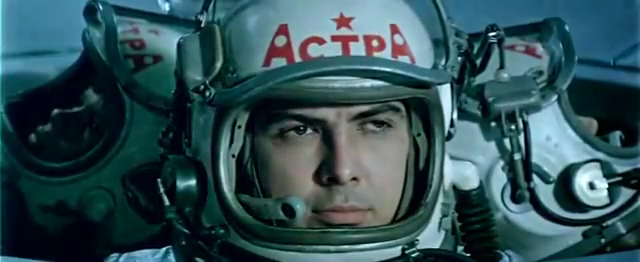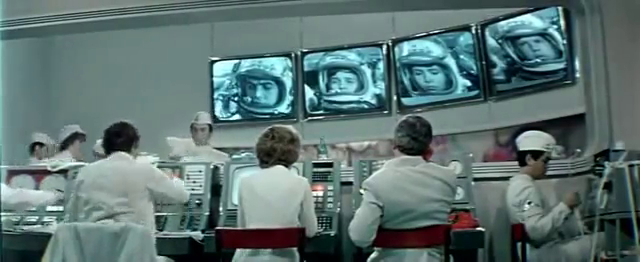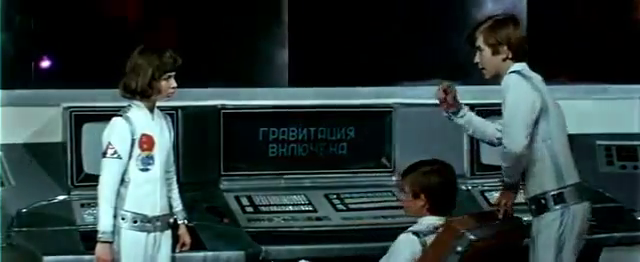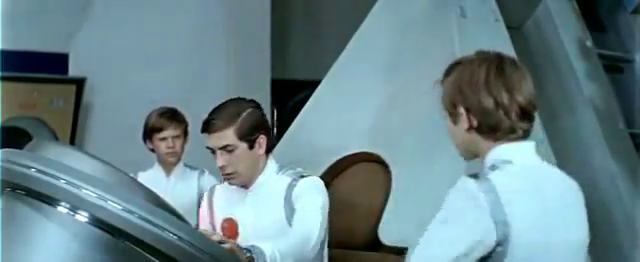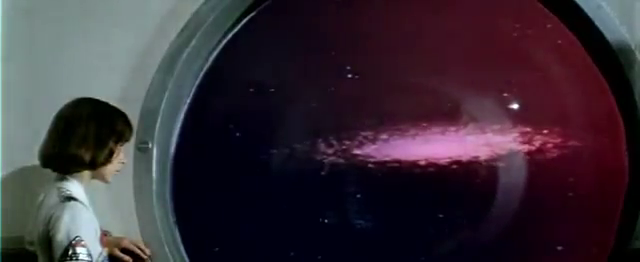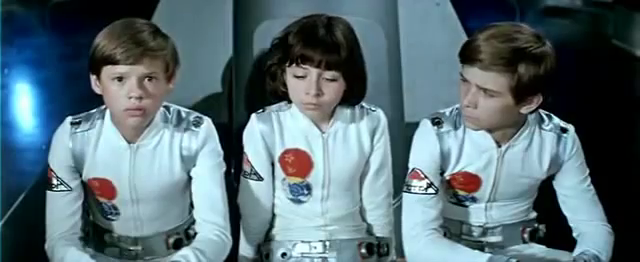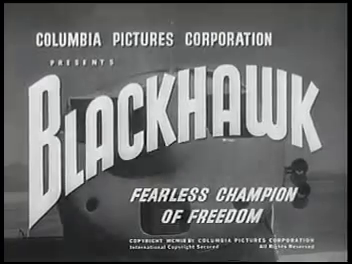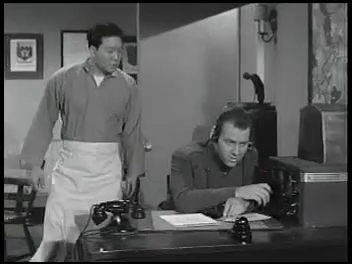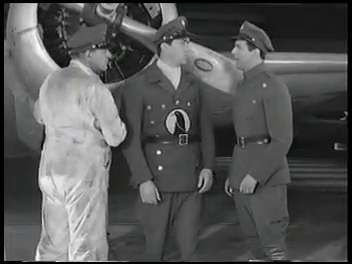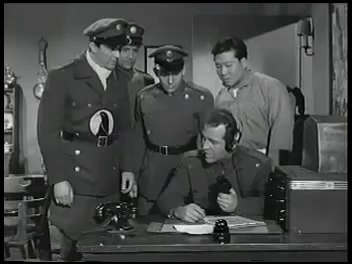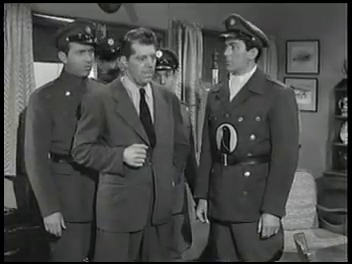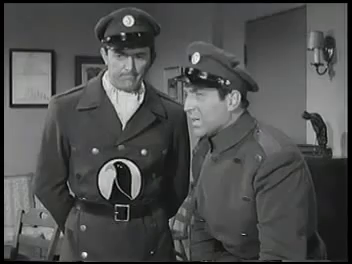-
#467 – Panther Girl of the Kongo (1955)
Panther Girl of the Kongo (1955)
Film review #467
Director: Franklin Adreon
SYNOPSIS: Jean Evans, a member of a wildlife foundation, is in Africa taking photos of local wildlife when she encounters a giant crayfish that nearly kills her. She teams up with Larry Sanders, a big game hunter, to stop the creature and discover it’s origins.
THOUGHTS/ANALYSIS: Panther Girl of the Kongo is a 1955 serial produced by Republic Pictures and comprised of twelve chapters. The serial centres around Jean Evans, who works for a wildlife foundation taking photographs of wildlife. She is known as “Panther girl” because…I don’t know, she rides an elephant sometimes and dives off cliffs; the only panther I recall seeing is at the end screen. Anyway, she encounters a giant crayfish that attacks her, but is saved by Larry Sanders, a big game hunter in the area. The two team up to try to stop the monster and unravel the mystery of it’s origins, while trying to stop two outlaws in the area. This is the cornerstone of the plot, alongside Dr. Morgan, a scientist also in the area, has created the giant monster to scare off people from a mine full of diamonds while he harvests them all. Obviously, this type of plot has been done to death, and is perhaps more famously associated with a vast chunk of episodes of Scooby-Doo, meaning it’s hardly an interesting watch nowadays when it’s been done and done again. There’s also not much of a plot besides this, and the heroes trying to stop the giant crayfish monster thing. Trouble is, it doesn’t show up for a good chunk of the serial, and so Jean and Larry are left to do the typical back-and-forth with Morgan’s henchman, as they make plans, set traps, and start fistfights with each other. As it is, the plot rarely has any direction, and the stakes are also pretty low, since again it’s not all for world domination or anything, just a man wanting to mine some diamonds in the middle of nowhere.
Quite rarely for a serial, the main character is a woman. Jean Evans is the “panther girl” due to her prowess in the jungle (even though there’s no panthers that we see), and she actually does something other than being kidnapped. The only other serial that does this to this degree is perhaps Jungle Girl (more on that later). However, when the script requires it, she does revert to the typical screaming damsel in distress, and the male lead swoops in to save her. He also does most of the shooting and punching, but still Jean’s character is central to the plot. Larry is just a typical male lead with no real character. The villains also are just typical henchman and a “mad” scientist who isn’t all that mad, just wants to get rich. The setting of non descript “Africa” and its stereotypical depiction of “tribes” is problematic and presenting the entire continent in this way is a depiction that prevailed for decades thanks to films such as these.
The serial is quite similar to the Jungle Girl serial released in 1941, particularly with regards to a jungle-savvy female lead. This is also not coincidental, as this serial uses a lot of the footage from the serial, particularly the on-location stuff and animals. In 1955, the serial format was really on it’s last legs, and it’s no surprise that the studios wanted to do as little new stuff as possible (although cost-cutting and re-using footage has been a staple of the serial format for years at this point). Since Jungle Girl was released fourteen years before, and theatre-goers probably wouldn’t have seen it or forgotten about it due to the lack of home media releases, and the only way to see older serials would be to watch re-releases at theatres, which I believe were somewhat rare, and even then they really don’t benefit from repeated viewings. The re-used footage is pretty heavy in the finale, when the action sequences are almost entirely made up from this footage, and the transition between the different footage is very awkward and disjointed. For example, you can clearly see “Jean’s” outfit change from scenes as she instantly switches from a miniskirt to swinging from the trees in leggings. The “giant” crayfish is obviously not a giant one, just a regular one filmed amongst miniatures. It’s not particularly convincing, especially when the “giant claw” attacks people with the rest of its body just offscreen. Overall, Panther Girl of the Kongo is a fairly weak serial, in which it’s most interesting aspects are just bits of re-used footage. The plot is non-directional and has fairly low stakes, alongside often feeling it’s just padding for the more interesting re-used footage. The emphasis on the female lead is a more unique aspect, but she is reverted to the typical “damsel in distress” when the plot wants to do a more typical set-up of the female being the victim. The serial is very low on imagination and spectacle, and is emblematic of the serial format in it’s twilight years as the format became unviable with the introduction of televisions in homes.
-
#466 – The Lost Planet (1953)
The Lost Planet (1953)
Film review #466
Director: Spencer Gordon Bennet
SYNOPSIS: Investigating a suspected U.F.O. crash in the mountains, reporter Rex Barrow and photographer Tim Johnson head there to check it out, but find themselves captured and sent to the planet Ergro by scientist Dr. Grood, who sends them to work on the planet to mine minerals and build his inventions to take over the universe. Rex, Tim, captured scientist Professor Dorn and his daughter Ella must overcome Grood’s mind control device and other contraptions as they try to put a stop to his evil plans…
THOUGHTS/ANALYSIS: The Lost Planet is a 1953 serial produced by Columbia Pictures and comprised of fifteen chapters. It is the last science-fiction serial that the studio produced (although the studio itself only produced three serials which could be fully described as “science-fiction”). The serial starts out with reports of a flying saucer crashing on Mount Vulcan, and reporter Rex Barrow and photographer Tim Johnson go to investigate, but end up getting captured along with Ella Dorn, and taken by rocket ship to the planet Ergro, where evil scientist Dr. Grood has taken over the planet to mine a new element that fuels his evil inventions. The plot of the serial revolves around trying to stop Grood and his various inventions, most notably his mind control device, which places prisoners in his power. It’s not only that though: this element that Grood is mining also fuels inventions such as a death ray, mind-reading device, invisibility and a whole host of other sci-fi tropes. Normally just one of these inventions would be enough for a serial to focus on, but here they’re all thrown into the mix. While this helps with keeping the serial varied across its fifteen chapters, it also has the effect of having little focus on any one of them. The one which stands out most is the use of the mind-control/hypnosis device. which is probably the least interesting of them all, and a lot of the plot just revolves around being hypnotised and de-hypnotising certain characters, creating a predictable back-and-forth.
One of the interesting aspects of this serial is that it seems to have been planned to be a sequel to the Captain Video serial. A lot of the same actors return, and the costumes and props are obviously re-used from it (for example, the outfits of the “video rangers” are used for the uniforms of the brainwashed people on Ergro). Whether the idea of making this a sequel was scrapped early on for some reason is anybody’s guess. The characters themselves are an unassuming bunch, and fit the typical parts that these serials provide. Unlike Captain Video though, this serial actually has a female character, although as usual, her only noteworthy aspect is being related to another more important male character. There’s a number of villains that have their own unique personalities and play off against one another, but it never really develops into something remarkable, and the web of villains just becomes confusing and muddled. Particularly as the serial switches between Earth and Ergro constantly.
In terms of production, there’s some decent sets in this serial. The rocket ship looks good, and the space travel sequences between Earth and Ergro look pretty good, considering in 1953 no one had ever been into space. The acting is not great, but there’s definitely worse performances I’ve seen in serials. It might have gotten away with it, but some of the dialogue is pretty dull and loaded with technical jargon that the actors seem to be convinced about saying. One other problem is that both Earth and Ergro look exactly the same; obviously because both are filmed in the California hills like every other serial, and as such this adds to the confusion surrounding the story, as both planets look so alike you don’t know where you are some of the time. Another curious decision about the making of the serial is that there’s none of the typical fistfights you get in nearly every serial: the only time someone throws a punch is when Rex is turned invisible, and so even then, you can’t see him actually throw the punch. This is incredibly strange, most notable because Spencer Gordon bennet, the director, practically invented the choreography for serial fistfights. Maybe they wanted to focus on the scientific inventions and their varied effects for the action, but even then, as mentioned, this is only the third sci-fi serial Columbia made, and it seems a bit out of their comfort zones.
Overall, The Lost Planet is a bit of a mess, and suffers from attempting to do too much. The inventions and sets are cool, but they’re all just props without a decent plot to coalesce around. The stakes are pretty detached as most of the action unfolds on this non-descript planet, and the characters fail to make an impact despite having such a large cast. The lack of action in this serial is very questionable, and the array of inventions don’t really fill in the gap. The whole serial is full of typical set-ups and schemes, but fails to give any motivation for the characters, or direction for a plot to develop.
-
#465 – T.O.R.R. Dawn of the Red
T.O.R.R. Dawn of the Red (2011)
Film review #465
Director: Robert Towne
SYNOPSIS: In the near-future, global instability and war is rife, and the CIA recruits army Captain Beck for a mission deep into enemy territory, where he and his team are to stop a Russian warlord from unleashing a new biological weapon…
THOUGHTS/ANALYSIS: T.O.R.R. Dawn of the Red is a 2011 action film. Set in the “near-future” of 2014, the world is in a period of instability, with new wars and separatism rife across many countries…apart from the United States, which seems to be carrying on as normal (American exceptionalism means those sorts of things never happen there). Captain Beck, a member of the U.S. Army, is summoned by the CIA to escort one of their agents, Sophie Delgado, deep into hostile Russian territory to prevent a local warlord from releasing a new biological weapon. The plot in this regard is simple to follow: it is an action film with a team of soldiers going into enemy territory to stop the bad guy. You don’t need much more than that. When the film tries to create more of a story behind the motivations of the mission and characters, it falls down a little because the dialogue is lacking in impact due to a combination of unconfident acting and muffled audio (more on that later). The editing also hinders this, with cutaways that are meant to explain the plot hurting the pace of the film, and feeling more like an exposition dump. You won’t be expecting too much from the film’s story, but still, it’s confusing details and detours detract from the action-oriented nature of the film as a whole. There’s also some pretty funny moments which I’m not sure are intentionally meant to be, such as a terrorist jumping out of a fridge opening fire, which again makes the tone of the film quite uneven, as you’re not sure how seriously you’re meant to take everything.
The characters again are pretty consistent with the genre, with the main character Beck being a chauvinistic soldier with an attitude problem towards escorting a woman. That’s his only personality trait. Agent Delgado as the only female character obviously conflicts with Beck, but it never develops into anything unique. Perhaps quite surprisingly, it also doesn’t develop into something romantic, which is usually how these things usually go in films. The rest of the cast are pretty forgettable, apart from the Russian warlord “Rasputin,” who is definitely overplayed and hyped up as a villain, even though he’s not really around too much. The characters are further diminished by some very poor acting, and a number of times the actors mess up their lines, and obviously a second take should have been done.
About halfway through the film the action changes tone a bit as we are treated to…zombies. It turns out this biological weapon turns people into “reanimated” corpses, and the team have to fend off waves of zombies instead of soldiers. Again, the tone of the film is subjected to an unexpected change that isn’t set-up, and you’re left wondering how seriously to take everything as the military action switches to this horror zombie survival plot. I suppose the title “Dawn of the Red” is meant to be a double reference to the films Red Dawn and Dawn of the Dead, which I guess this film could be seen as a combination of, and hints of what to expect, but that’s a stretch (I also have no idea what T.O.R.R. is supposed to stand for).
This is obviously a low-budget film, and so there’s a number of production issues that are very distracting and disrupt viewer’s immersion. Apart from the shaky acting mentioned above, the dialogue is very inorganic, and attempts to wax philosophical come across as unoriginal and not worth listening to. Apart from the choppy editing that breaks up the action, one of the most distracting things is the poor quality of the audio and how everyone’s voices are muffled or echoes significantly. Some of the zombie/reanimated make-up is very obviously fake as well, but the film hides it a bit in dimly lit rooms. The lighting overall is also something that stands out, with a lot of scenes being filmed in this weird night-vision which creates a high contrast and obscures some of the action. There’s some attempt to create different lighting effects depending on the situation, but they are typically overpowering. The low framerate of the cameras being used also lead to significant blurring, particularly during the action scenes, which means you can barely tell what’s going on sometimes, and combined with the poor audio, makes it completely unengaging. In a more positive respect, the film makes use of a variety of on-location sets, from deserts to snow-covered forests, which is better than similar low-budget films that might confine themselves to abandoned buildings or greenscreens (of which there are none that I could see in this film).
Given that this is an independently made film without much budget, it is unfair to compare such films to big-budget Hollywood productions. However, even in the context of independent films, T.O.R.R. leaves very little to recommend it. The plot is an unsynthesised mix of military action and zombies that is inconsistent, and the mix of action, horror and silly one-liners will leave viewers alienated from anything that goes on screen as they’ll be left wondering how to connect with what is happening. The story and characters are completely forgettable, and the poor dialogue and delivery of lines further stifles engagement. While there’s obviously been a decent amount of effort put into this film with regards to location shots, and getting authentic looking weapons, the poor audio and blurry visuals combined with obtuse selection of lighting makes many scenes incomprehensible, and ruins most of the positive moments the film has. Overall, I don’t think there’s anything unique or interesting to recommend here.
-
#464 – The Great Alaskan Mystery (1944)
The Great Alaskan Mystery (1944)
Film review #464
Directors: Lewis D. Collins, Ray Taylor
SYNOPSIS: Dr. Miller, along with Dr. Hauss, has invented a new death ray called the paratron. However, Dr. Hauss is secretly a Nazi spy, who intends to steal the death ray to give to his home country. Jim Hudson, an adventurer of sorts, tells Miller that the material he needs to complete the paratron may be found in the Alaskan mines, and so they set off there, only to have their plane crash on the way…
THOUGHTS/ANALYSIS: The Great Alaskan Mystery is a 1944 serial released by Universal pictures comprised of thirteen chapters. The serial centres around the invention of a death ray called the “paratron,” invented by Dr. Hauss and Dr. Miller. However, they are having trouble completing it. Jim Anderson, an adventurer who knows Dr. Miller’s daughter Ruth, visits and remarks that a rare mineral that can be found in mines in Alaska might be what they are looking for. They all set out on a boat to Alaska, but various machinations are at work, as Dr. Hauss is secretly a Nazi spy, and intends to steal the paratron for his own country, getting the Captain of the ship to aid him in his scheme. The ship sinks and the cast are forced to survive in the Alaskan wilderness until they are rescued. The first two or three episodes are quite varied and dump the cast straight into the Alaskan wilderness doing what you would expect them to di in Alaska: getting caught in the snow, visiting Inuit natives, and such. After chapter three, the serial settles down into a more typical format, with the heroes and villains engaging in a back and forth as they try to get a hold of the paratron and stop each other. In terms of story then, it’s a standard serial affair. The stakes aren’t particularly high as everything revolves around this death ray which while is indeed powerful, doesn’t seem as revolutionary as some other inventions used in these serials (maybe because the idea of the death ray has been done to death). Also this is a wartime serial, and the stakes here probably pale in comparison to the real war going on at the time. There’s also perhaps something to be said for the fact that the setting of Alaska makes the serial feel somewhat removed from any wider context. However, the serial does make good use of the Alaska setting, as we get a decent amount of shots of the wilderness and unique set-ups in the mountains and snow, even if they rely heavily on stock footage.
The cast for this serial is fairly large. However, none of them really stand out, and fall into very typical serial roles. The cast does however, consist of a number of popular and well-known actors of the time, which enhances the serial with some decent performances. You have the typical protagonist, the sole female character, and the elderly scientist, along with the villains and their henchman. There’s also plenty of characters pretending to be helping the heroes when they are the villains. it all adds up to quite a mystery, but never really flows into a coherent experience as all the characters are easy to get mixed up and don’t form their own unique performance.
As mentioned, the depictions of Alaska are perhaps the most unique part of the serial, with plenty of scenic shots, lumberjacking, and wilderness sets that make it look the part. The dialogue is what mainly drives the story though, as with most Universal serials. There’s not a lot of action scenes outside of some classic shoot-outs and chase scenes, and again that is typical of a Universal serial, which usually are less action-oriented than the ones from rival serial producer Republic. Overall, The Great Alaskan Mystery has many of the serials tropes that it needs to, but fails to bring it’s busy story and large cast together to create anything special. It’s got everything it needs, but is ultimately a bit forgettable, leaving it to be remembered as just another average serial amongst the many of the format.
-
#463 – Alien Invasion (2020)
Alien Invasion (2020)
Film review #463
Director: Yun Xiang Lin
SYNOPSIS: Private detective Xu Siwei is hired by Yang Lin to investigate the disappearance of her Father. They are led to a secret underground facility where they encounter a strange portal to an alien world. Barely escaping the alien horrors within, Xu is haunted by strange dreams that relate to this alien species, and heads to the town where Yang Lin was raised to find answers…
THOUGHTS/ANALYSIS: Alien Invasion is a 2020 science fiction film. The film starts off in a secret laboratory where an experiment on an alien portal goes wrong and a creature escapes into the laboratory, forcing it to be sealed to prevent the alien’s escape into the world. Next, we are introduced to private detective Xu Siwei, who after capturing a thief returns to his home to find Yang Lin, a young woman who wants to hire him to find her Father, who went missing fifteen years ago. The two are led to a secret laboratory where they stumble upon the alien portal from the opening of the film. They manage to escape, but Xu starts having recurring nightmares about the aliens, and seeks to unravel the mystery further by visiting Yang Lin’s hometown, where strange things are happening. The plot of the film is inspired by the Cthulhu and other such eldritch horror, as the alien in the opening scenes shifts its amorphous form and impales people with its tentacles. The film is essentially a science-fiction thriller, attempting to build tension in the mystery it creates and the environments in which it is set. The film struggles to do this successfully because the whole tone of the film is very inconsistent: at the start there’s some more action and quirky light-heartedness, as Xu is clearly emulating Benedict Cumberbatch’s portrayal of Sherlock Holmes. The film leans more towards a horror theme as Xu and Yang investigate the laboratory, and more of a slow-paced thriller as Xu and Yang investigate what happened to her parents in the town she grew up. With these constant shifts in tone, the flow of the story is constantly interrupted and it it becomes difficult to maintain engagement in the story.
The film centres around the two main characters Xu Siwei and Yang Lin, who investigate Yang’s father’s whereabouts after he disappeared some fifteen years ago. As mentioned, Xu is clearly ‘inspired’ by Cumberbatch’s portrayal of Sherlock Holmes, but that part of his character doesn’t really factor in after the first act when the film shifts to a thriller and the mystery overshadows any character quirks. Yang has plenty of mystery about her, but there’s nothing too special about her character. The chemistry between the two is alright, but could probably have been pushed further to increase the stakes. Overall they’re pretty standard characters from the genre, but still fairly likable, and supplemented by decent acting on behalf of the actors.
The film is very much on par with other Chinese science-fiction released around the same time in terms of production, which means in terms of the CG is that it doesn’t look too bad, but it also typically looks like someone put it together in After Effects in an afternoon. The colour is one thing that I think stands out, as it is vivid without making the scenes lose their tense atmosphere. The practical effects look pretty daft, particularly the aliens which are obviously people in very silly looking masks that are quite distracting. The fact that we don’t see any of the aliens for a good majority of the movie again breaks the sense of flow, as we are treated to this set-up at the start, then nothing really comes of it for most of the movie. The whole mystery surrounding Yang’s mother and father also never gets a satisfactory payoff, as everything is delivered in cryptic riddles and not explained properly. Overall, Alien Invasion is a fairly standard Chinese science-fiction film of its type, and is unremarkable in terms of story, characters or production. It’s inspirations are obvious, and does little to develop or explore them in any unique way, making it a fairly forgettable experience.#movie#movie review
-
#462 – Mysterious Island (1951)
Mysterious Island (1951)
Film review #462
Director: Spencer Gordon Bennet
SYNOPSIS: A group of soldiers fighting in the American civil war are captured by Confederate forces. They eventually escape on an observation balloon, but find themselves drifting for days, eventually landing on a desert island far from civilisation. However, the island is far from deserted, as a native tribe, pirates, aliens, a castaway, and a mysterious masked man are all up to various schemes on the island, and the new arrivals must find a way to survive against all these different factions and find a way home…
THOUGHTS/ANALYSIS: Mysterious Island is a 1951 science-fiction serial comprised of fifteen chapters. It is based on the novel of the same name by Jules Verne. The serial is set in the year 1865, during the American civil war, where during the siege of Richmond, Virginia, Captain Cyrus Harding is captured by Confederate forces and taken prisoner. he engineers an escape with some other prisoners by hijacking an observation balloon. Unfortunately, a storm sweeps the balloon way off course, leaving it to drift for many days. When it lands, the crew find themselves on a desert island far from any civilisation, with no way home. They quickly find that the island is far from deserted however, and the new arrivals must contend with multiple factions and their schemes. As mentioned, the serial is based on Jules Verne’s novel of the same name, and incorporates a fair amount of the novel’s structure and characters. This is in contrast to a lot of serial adaptations of comics and books, in which usually only one or two main characters are made to fit into the serial format, omitting a lot of the original’s world and set-ups (such as things that would be too expensive to implement). As such, the serial has a good flow and pacing that keeps things interesting across the fifteen chapters. There’s still plenty of tried serial tropes when characters set up elaborate deaths with plenty of opportunity to escape rather than just killing them, but on the whole there’s plenty going on between all of the different factions to keep things varied and interesting. Even through the fifteen chapters, which is at the longer runtime of these serials, it keeps things consistently entertaining.
Let’s talk about the characters in this serial: there is a very large cast, and multiple different factions that are working against each other. Apart from the main cast that wind up on the island, there’s the native population, a castaway that has gone mad, pirates, aliens from the planet Mercury, and a mysterious masked man. In keeping with the novel, all of these characters are from the source material apart from the aliens from Mercury, which were added for the serial. The serial could have easily got away with not adding them, as there’s plenty of characters and plot anyway, but I suppose they were added to keep up with trends, as sci-fi serials and films started to get more popular after World War II had ended and the subsequent years in which war heroes were the protagonists of choice. The alien characters and plot fit in fairly well and are incorporated into the story so that they don’t stick out as a forced inclusion, which is good. While none of the characters are really unique or memorable, they have a consistency in their acting, and you know who they are and who they’re aligned with when they’re on screen. The heroes are perhaps the least interesting bunch, as they’re all typical young male leads without any special talent or occupation. Nevertheless, you will be on their side as they try and make their way home.
Mysterious Island is a nice surprise in the period of the serial format’s declining popularity. Obviously helped by being based off a famous novel helps give the story an interesting set of characters and set-ups, the serial also incorporates its own elements which, while nothing unique, is integrated nicely with the rest of the source material, even if the sound of pirates, American Civil War, and aliens together sounds like an absurd mix. The acting is decent, the sets convey a consistent sense of location, and the story has a good sense of direction that maintains interest and excitement. Spencer Gordon bennet, the director, was a serial veteran by this point, and delivers his usual developed choreography in fight scenes and keeping the pace of the serial steady yet energetic. Overall, Mysterious Island is a surprisingly decent addition to the serial format, at a time when good examples of it were few and far between.
-
#461 – Ninja Apocalypse (2014)
Ninja Apocalypse (2014)
Film review #461
Director: Lloyd Lee Barnett
SYNOPSIS: in the post-apocalyptic wasteland, a summit is called between the various ninja clans for peace talks, as clan leader Fumitaka believes the clans must come together to overcome an external threat that threatens all of them. The clans agree to the terms, but Fumitaka is suddenly assassinated, with witnesses saying that Cage, leader of the Lost Ninja clan, was the one who did it. Cage and his fellow clan members are forced to flee, and must find a way out the bunker where the peace talks are being held, with all the other ninja warriors out to get them…
THOUGHTS/ANALYSIS: Ninja Apocalypse is a 2014 post-apocalypse martial arts film. Set after the collapse of society through nuclear war (as with most post-apocalyptic films), what remains of humanity seems to have banded into various ninja clans (for some reason). Fumitaka, the leader of one of the clans, holds a peace conference between the clans at his bunker, where he claims they must unite to fight an “external force” that threatens them all. The clans agree, but Fumitaka is suddenly assassinated, and three witnesses claim it was Cage, the leader of the Lost Ninja clan, that did it. Cage and his clan ninjas flee, attempting to escape the bunker while fighting off the remaining clans. The story is fairly simple to follow, even if it doesn’t make much sense: why is everyone a ninja in the post-apocalypse? Why do they have magic powers? Are they mutations or supernatural? Not much is explained, but then again it is a martial arts movie, and doesn’t need too much explanation. The whole premise is very silly, and manages to get even sillier when it introduces zombies. Overall it’s not a story that will keep your interest, and while there’s a few twists and surprises, doesn’t offer too much.
The various clans of ninjas we see at the beginning of the film all have unique special powers, including lightning, fire and illusion. As mentioned, there’s no explanation of these powers and whether they are mutations or supernatural, but it’s not too much of a concern. Apparently their powers have a certain limit and have to recharge, but it’s mechanics are not explained any further. These abilities make the film a bit more over-the-top and unique, but they’re not utilised in a massive way to bolster the film as a whole into a unique experience. The characters themselves are a fairly typical bunch of tropes, with Cage and his brother Surge being at odds with one another forming the most notable relation between characters. Cage’s rivalry with Becker, leader of the fire-based ninja clan, is also fairly interesting, and it’s fun to watch them interact, but there’s too little of it. The big reveal of the villain at the end has little impact too because we see very little of Cage and the villain actually interacting, so we are left only with exposition to fill in the gap.
This is not a high budget production. The film is almost exclusively set in this nuclear bunker, which means there is no need for complex sets, and most of the action takes place in non-descript corridors, stairwells and industrial empty rooms. The CG is pretty basic stuff and probably something anyone could make in After Effects, but it’s not overused too much, and is mainly just to create blood splatter, which the film doesn’t linger too closely on (although sometimes the physics of the blood is noticeably off). The acting can sometimes be alright, but other times is very stuff and wooden, making the whole experience very uneven. The most important aspect of a martial arts film has to be the fight scenes, and the ones in Ninja Apocalypse are…fine I guess. The actual stunts and fighting are good, but the editing of them is often too sharp and ruins the flow. There’s plenty of variety though, from the various ninja clans and their unique powers to slicing up zombies. Overall though Ninja Apocalypse is a fairly forgettable affair with a threadbare story and limited characters. There’s a few decent stunts and fights, but they are ultimately hampered in their editing and composition. There’s not much to really take away from this film, apart from the premise should be much more interesting than what is delivered on screen.
-
#460 – Spy Smasher (1942)
Spy Smasher (1942)
Film review #460
Director: William Witney
SYNOPSIS: The masked hero “Spy Smasher” is captured in Paris on a secret mission to obtain plans for sabotage operations in the United States. He escapes back to his home country, where he is reunited with his brother Jack. However, the Nazis have also made their way to America shores, and the two team up with intelligence officer Admiral Corby to counter the threat…
THOUGHTS/ANALYSIS: Spy Smasher is a 1942 movie serial comprised of twelve chapters. It is based on the comic book series of the same name. The serial opens up in Paris, where the eponymous masked hero “Spy Smasher” is on a secret mission to obtain plans for a sabotage operation to be carried out in the United States. He is, however, captured, and after unsuccessful torture attempts, he is sentenced to death in front of a firing squad. Fortunately, a member of the French resistance, Pierre Durand, fakes his death, and is able to smuggle him back to the United States. The opening of this serial is quite uncharacteristically dark compared to others of the genre: The scenes of torture (implied, but shown just offscreen), and the firing squads are perhaps a more authentic look at what was happening during WWII at the time than other serials portrayed. From the outset, the serial feels a little more grown up than others, which is odd considering they were mostly aimed at younger viewers. Back in the United States, the Nazis have snuck in and are on a train to carry out their plans, when one of them recognises Spy Smasher and attacks him. It turns out that it is not Spy Smasher at all, but his brother Jack, and Alan (who is Spy Smasher in disguise) defeats the Nazis and reveals himself to his brother. The two team up with navy intelligence officer Admiral Corby and his daughter Eve (Jack’s fiancée) to counter the Nazi threat that Alan/Spy Smasher helped to expose. The rest of the serial’s story is simple enough to follow, but there’s a lot of different locations, such as Spy Smasher returning to Paris to free Pierre from the Nazis, which helps keeps things varied and interesting. The variety slows down in the latter half of the serial, but the finale has plenty of action and consequences to make it pretty enjoyable.
The characters are (as always) a familiar bunch insofar as they all follow very specific tropes that form the backbone of the serial format’s character roster. Jack and Alan are the typical young male stars that do all the action sequences and punch plenty of Nazis in the face. Admiral Corby is a typical older man that serves as the boss who receives intelligence and gives instructions. His daughter is the token female, who serves the typical role of simply being a family relation to a male character. It’s a pretty small cast, but it means that more time is focused on the actions of Spy Smasher, which is what you want to see really. The villains are Nazis. That’s it. They are mostly in their full uniforms somewhat faithfully recreated, whereas a lot of serials simply imply that the villains are Nazis, or working for a “foreign country.” The villains are led by a masked individual known unsurprisingly as “The Mask.” Despite the fairly decent costumes on the villains, the mask for The Mask is literally a piece of white cloth covering his face with some holes cut out for the eyes. I’m not sure why they bothered, since his identity isn’t of any importance, and he routinely removes it when communicating to certain people. The mask is apparently the villain from the comics, so I suppose he was just added to tie in with the comic, but he doesn’t stand out as a unique villain.
The production values are pretty good for a serial, and although there’s no exotic or novel sets, what we do get is sturdy and has a decent scale. The action scenes on top of speeding trains and the like are also well done, and deliver a good sense of danger. As mentioned the costumes are pretty good as well…apart from The Mask’s “mask” anyway. There’s also some plots involving planes and ray guns, which again add to the variety. Overall, Spy Smasher is a serial that stands above the average in terms of quality in the genre, thanks to it’s variety in the story and its grounded, consistent logic, alongside some good production values and camerawork. It’s a very good example of the wartime serials that portrayed the Nazis as the villains, without the film being simply propaganda. All in all, worth your attention if you’re a serial fan.
-
#459 – A Great Space Journey (1974)
A Great Space Journey (1974)
Film review #459
Director: Valentin Selivanov
SYNOPSIS: The All-Union Children’s Space Competition aims to find three children that will be the first youths in space aboard a new spaceship. Sveta, Sasha and Fedya are chosen from the one hundred thousand applicants to embark on the mission with the sole adult on board, Captain Egor Kalinovsky. After the ship is launched, Egor is found to be sick, and placed in quarantine, leaving the children in charge of the spaceship…
THOUGHTS/ANALYSIS: A Great Space Journey is a 1974 children’s science-fiction film based on the play The First Three, or the Year 2001 by Sergey Mikhailov. The film opens up introducing a space program that will choose three children to be the first young people in space. Out of one hundred thousand applicants from across the Soviet Union, three children are selected: Sveta Ishenova, Sasha Ivanenko, and Fedya Druzhinin. The three are sent into space on the spaceship Astra with the only adult on the voyage, Captain Egor Kalinovsky, who is in charge of the mission. When Egor is found to have a fever, that may spread to everyone else, he is placed in quarantine, leaving the children having to take charge of the ship and the mission. The story is fairly simple, being a film aimed at children, and is fairly light on the details concerning what the mission they are on actually is. Nevertheless, there is plenty that is going on in the film, as the children have to navigate through a fair amount of emergencies and strange situations as their journey continues. Not having an overarching objective hinders any sense of direction and accomplishment the film has, but nevertheless, there’s a good sense of adventure and enough variety to capture viewer’s imaginations. There’s a bit of a twist in the story that explains most things at the end, but I’ll discuss that at the end too.
The three main characters are the children that were chosen through the space program. Each of their characters are developed through flashbacks to when they were undergoing the testing, highlighting their relationships with their parents and each other. There’s also Egor, the only adult on the spaceship, who is placed in quarantine, but can still communicate to the others. One of the children, Fedya, is placed in command of the mission after Egor is quarantined, and it is hinted that he is troubled by something about the mission, but refuses to disclose it. Sasha is very animated, and teaches the other children dance moves to keep them entertained. Sveta is more headstrong and quick to rush into situations (contrasting with Fedya’s more reserved nature) and perhaps has some romantic feelings for Sasha. Between the three children, they have a good range of personalities, and at least one of them will appeal to children that the film was aimed at. Their interactions feel genuine in this extraordinary situation, and are generally likeable in their own way. There’s also a good balance between the children needing to act like adults, and also like children; such as when they complete their task running the spaceship, and immediately go get some ice cream from a nearby fridge.
The ending of the film reveals that the entire mission is actually just a simulation for the children to test their abilities. Fedya initially works it out, but keeps it secret for the remainder of the mission. You might think this is a bit underwhelming and disappointed that the children do not actually go into space…and in fact, that’s why actual soviet cosmonaut Alexey Leonov appears at the end of the film saying this exact thing. He also says that the time will come soon (?) when children will really go into space, and encourages children to continue looking forward to it and chasing their dreams, which is nice. The film also rewards the children for the completion of the simulation with a celebration and fanfare, so it still feels rewarding, and as if the characters accomplished something.
The quality of the sets and production values of the film certainly deserve some mention. The set of the spaceship is detailed, and the shots of the ship travelling through space are quite convincing given the time it was released. the model shots of the spaceship and other things also have quite a lot of detail in them. The whole aesthetic evokes the look of 2001: A Space Odyssey, which I’m sure is no coincidence. Given that the play the film is based on is called The First Three, or the Year 2001, it would certainly there’s a connection, but whether it is an homage, a parody, or knock-off, I’m not sure. The film was also apparently in production for two years, which I think shows in the look of the finished product. There’s also some musical interludes which don’t really fit in too well, but again probably something children would enjoy. Most notably, the song’s were written by a young Alexey Rybnikov, who would become one of the Soviet Union’s and subsequently Russia’s most famous composers, apparently in no small part due to the popularity of the soundtrack of this film.
Overall, A Great Space Journey is a fun little adventure that I’m sure its target audience would have enjoyed. The film is well constructed, and great effort had obviously been taken to make detailed and engaging sets. The characters themselves are relatable and distinct, without being too much of walking tropes, and the story has plenty of things going on in it, even if it lacks direction or purpose sometimes. It packs in a fair amount of detail and adventure in just over sixty minutes, and with some decent editing, always has something interesting going on.
-
#458 – Blackhawk (1952)
Blackhawk (1952)
Film review #458
Directors: Spencer Bennet, Fred F. Sears
SYNOPSIS: The elite group of air pilots, The International Brotherhood, led by the heroic Blackhawk thwart threats to the country without the use of weapons. They are tasked with stopping a foreign spy and her various schemes, leading to a series of daring adventures.
THOUGHTS/ANALYSIS: Blackhawk is a 1952 serial comprised of fifteen chapters, based on the comic series of the same name. The action centres around the group of air pilots called The International Brotherhood, a group of former WWII pilots led by the heroic Blackhawk. They are assigned the task of bringing down a foreign spy named Laska, who is working for a mysterious Leader. The story revolves around Blackhawk and his boys foiling Laska’s plots which are fairly varied throughout the fifteen chapters. There’s no real overall plot other than just stopping Laska; there’s some smaller plots concerning death rays and recovering new energy sources which would be the full plot to some other serials, but this one condenses each of these plots into two or three chapters, which keeps things somewhat varied and interesting, as some serials that hinge around just one of them get stale very fast. However, having very little to tie the whole serial together makes it suffer a lack of direction. On the other hand however, it’s just good guys chasing bad guys, and that’s all it needs to be. If you’re watching a serial, you won’t be expecting a complex narrative, and they’re mostly for younger viewers as well, so they just want to see the good guys fight the bad guys, and on that point the serial has enough action to make it interesting enough. You also have three or so chapters in Mexico in a more self-contained story, which would have been an optional part for cinemas to purchase depending on whether they bought either the twelve chapter or fifteen chapter version of the serial (a fairly standard practice at the time).
The heroes are a group of former WWII air pilots that work together to take down foreign enemies in their planes. They also make a point that they don’t use guns or weapons, but never explain why. Perhaps it’s something they did in the comics. The head of these pilots is Blackhawk, who is a very typical protagonist, being the young-ish, stocky man who gets to throw plenty of punches. The rest of his team don’t have much character themselves, and just serve as an extra pair of hands for piloting planes and throwing fists in a fight. The villains are also fairly forgettable, with the usual cast of henchman identified as working for the “Reds,” signifying the shift in America’s enemies after WWII. Laska, who serves as the main villain is played by Carol Forman, who played quite a few similar lead female villains in serials such as The Black Widow and Superman. She knows how to play the role, but her character is never given any motivations or depth, and simply serves as a simple villain. There’s also a mysterious Leader who gives Laska her orders, whose identity is kept secret until the very end. He only appears very sporadically, and his identity has no impact on the story. In fact, I didn’t even recognise his character as it was one that was apparently killed off early in the serial.
Produced in 1952, after both WWII and the peak of the serials, Blackhawk has little to offer the genre. With serial veteran Spencer Gordon Bennet being one of the directors, the fight scenes are decently co-ordinated, and there’s some variety in the shots, but nothing too special. A lot of the climaxes of the chapters seem to end up in factories for whatever reason, but there’s some aerial combat too and the usual vehicles going off cliffs. As mentioned, the serial was released after the peak of the format, so there’s nothing special to write about. Even the spike in the popularity of war heroes as characters in serials that started after WWII was starting to wain in 1952 in favour of looking to the future with science-fiction and the space race. As such, this is the last serial that focused on air combat and planes. Overall, Blackhawk is a pretty standard serial, but fails to offer anything special.
